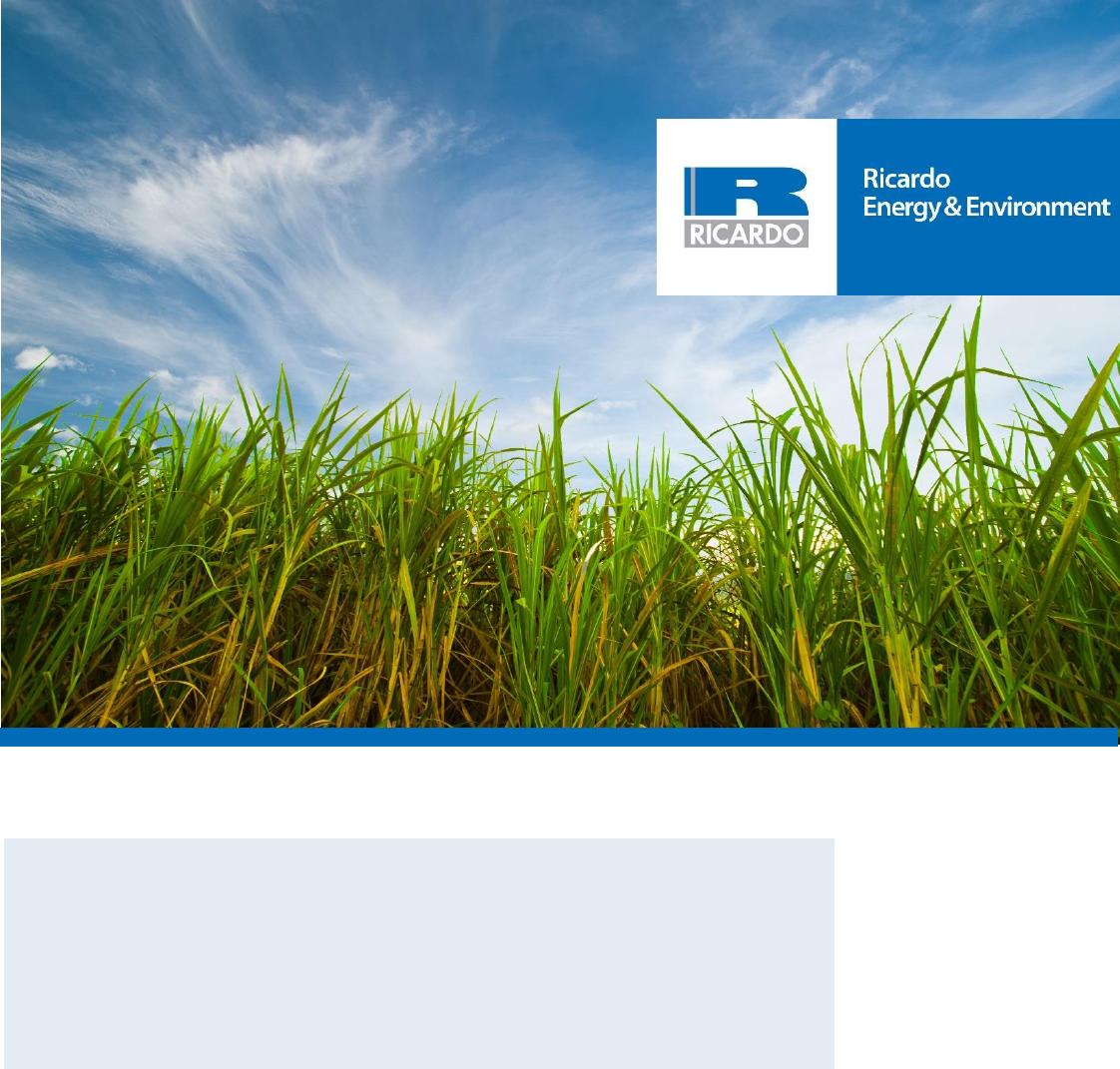GlobalbiomassmarketsFinalreport___________________________________________________ReportforBEISBEISReference:TRN906/10/2014GlobalbiomassmarketsiRicardoinConfidenceRef:Ricardo/ED10819/IssueNumber4RicardoEnergy&EnvironmentCustomer:Contact:DepartmentforBusiness,EnergyandIndustrialStrategyKathrynRushtonRicardoEnergy&EnvironmentGeminiBuilding,Harwell,Didcot,OX110QR,UnitedKingdomt:+44(0)1235753109e:kathryn.rushton@ricardo.comRicardo-AEALtdiscertificatedtoISO9001andISO14001Customerreference:TRN906/10/2014Confidentiality,copyright&reproduction:ThisreportistheCopyrightofRicardoEnergy&Environment,atradingnameofRicardo-AEALtdandhasbeenpreparedbyRicardoEnergy&EnvironmentundercontracttoBEISforCasestudiestoassessfutureglobalbiomassmarkets,18/09/2018.Thecontentsofthisreportmaynotbereproducedinwholeorinpart,norpassedtoanyorganisationorpersonwithoutthespecificpriorwrittenpermissionoftheCommercialManageratRicardoEnergy&Environment.RicardoEnergy&Environmentacceptsnoliabilitywhatsoevertoanythirdpartyforanylossordamagearisingfromanyinterpretationoruseoftheinformationcontainedinthisreport,orrelianceonanyviewsexpressedtherein,otherthantheliabilitythatisagreedinthesaidcontract.Authors:PatHowes,JudithBates,AdamBrown(EnergyInsightsLtd),RocioDiaz-Chavez(StockholmEnvironmentInstitute),StuartChristieandArleneBayley(4SightFutures)Approvedby:PaulMaryanDate:10July2018RicardoEnergy&Environmentreference:Ref:ED10819-IssueNumber4GlobalbiomassmarketsiiRicardoinConfidenceRef:Ricardo/ED10819/IssueNumber4RicardoEnergy&EnvironmentExecutivesummaryModellingoftheglobalbioenergyresourceindicatesthatpotentiallylargequantitiesofforestryresourcescouldbeavailableforsupplytotheUKfromseveralregionsaroundtheworld.Similarly,ifthemarketisright,internationallysuppliedenergycropscouldbeasignificantresourceinthefuture.However,theextenttowhichthesepotentialresourcesmayberealisedthoughnaturalmarketdevelopmentisunclear.Thisreportaimstoincreaseunderstandingoftheavailabilityofinternationalbiomass.Itlooksatdiversesituationsbyevaluatingoptionsfordifferenttypesofbiomassindifferentregions.Thishasallowedkeybarrierstothedevelopmentofbiomasssupplychainstobeidentified,andhowtheyvarybyregionandtypeofresource.Aspartofthiswork,themainenvironmentalandsocio-economicimpactsfrombiomasssupplyhavebeenconsideredalongwiththehigh-levelmeansbywhichthesecouldbemitigated.BiomasscostsandpricesThepotentialpriceofpelletsderivedfromavailableforestryresourcesandaccessibleenergycropsimportedintotheUKfromarangeofcountrieswasestimated.ThesewerefoundtobewithinthecurrentrangeofpricesforbiomassbeingpaidbytheUKmarket.TheestimatedfuturepriceofpelletsproducedfromUKenergycropswerealsoidentifiedashavingpotentialtoalsofallwithintherangeofcurrentmarketprices.Futureexpansionofpelletproductionfromarangeofregionsnotyetcontributingtoglobalsupplyispossiblebutwouldrequiretheuseofbiomassresourcesthatweremoreexpensivetocultivateorcollectandtransportthanresourcesusedforcurrentsupplies.Thiswillleadtosmallincreasesintheestimatedpriceofimports(typicallylikelytobeafewpercent).However,developmentofthemarketcouldalsoleadtoinvestmentsthatimprovetheefficiencyofthepelletisationprocessandtransportlogistics.Thesehavethepotentialtoenableincreasedsupplywithincurrentpriceranges.Inthecaseofenergycrops,productioncostscouldbereducedthroughinvestmentstodevelophigheryieldingvarieties,reducingestablishmentandharvestingcosts,andmovingtocontractfarming.Thedevelopmentofinternationalbiomasssupplychainsrequirespoliciesthatsupportthedevelopmentofastable,long-termmarket,andensureenvironmentalandsocialimpactsrisksaremanagedeffectively.Historyshowsthatprivate-sectorinvestmentandinterestwillnotbeavailableuntilsupportingpoliciesareinplace.Thispresentsachallengeforgovernmentstoestablishapolicyframeworkinadvanceofamarketandinthehopethatthemarketswillrespondasrequired.KeybarriersThereareanumberofkeybarriersthatexistinmostregionsthatcouldhavealargeimpactonsupplyifnotaddressed.Themostfundamentalarethoserelatedtomarketdevelopment.Akeymarketbarrieristheavailabilityoffinanceontermsthatenableproducerstoachieveanattractiverateofreturn.Thisisrelatedtoperceivedriskandislikelytovarybyregion.Financewillbemorereadilyavailableinregionswherethemarketandpriceforbiomassareclearandtheinstitutionalenvironmentisstable.Thismeansthatraisingfinancemaybedifficulttosupportbiomasssupplyindevelopingandemergingeconomies(suchasAfricaorSouthAmerica),wherepoliticalrisksand/orcurrencyrisk/volatilitymaybehigher.Energycropscouldprovideconsiderablebiomassresource,buttheypresentspecificchallenges:thereareupfrontcostsinestablishingthecropandreturnsareonlyachievedoverthelongerterm.Forthissituationalternativefinancingmodelsarerequired.Forinstance,financecouldbeprovidedbytheenduserofthefuelorbyinvestorsthatareabletotakealonger-termoutlook,suchaspensionfunds.Amajorbarriertodevelopmentofbiomasscanbethefinancialburdentothefarmerorlandownerofinitialinvestmentinplantingmaterialormachinery.Toaddressthis,alternativeapproaches,suchasGlobalbiomassmarketsiiiRicardoinConfidenceRef:Ricardo/ED10819/IssueNumber4RicardoEnergy&Environmentcontractfarmingapproachwillalsoberequired.Intheforestrysector,solutionsusedtomitigateriskandgainaccesstofinanceincludeencouraginginwardinvestmentfromlargeinternationalcompaniesthatcantakeontherisksinthebiomasssupplychain,andtheuseofjointventuresbetweenbiomassproducersandenergyplantdevelopers.Jointventuresbetweenbiomassproducersandbiomassprocessers(e.g.pelletplants)arealsobeingconsidered.Ingeneralterms,whilepriceincreasesmayhelptodiminishmarketbarriers,stakeholdersconsiderthatthisisonlyimportantwhereitleadstothedevelopmentofalarge-scale,stablemarketforbiomass.Akeymarketbarrierthatisverydifficulttoaddressiscompetitionforbiomasssupply,forexamplefromdomesticdemandinthesupplyregionandcompetingmarketsforthefeedstock.Competingmarketscanincludeenergy(suchastheemerginglowcarbonenergymarketsinAsia),ordemandforotherproducts,suchastheuseofthefeedstocksinbiorefineries.Ironically,anotherpotentiallysignificantbarrierinthefutureisreducedproductivityduetoclimatechange.Thisbarriermaybehardtoovercome,especiallyforenergycrops.However,increasedpricesforbiomasscouldprovidetheimpetusneededforfundingresearchanddemonstrationofvarietiesbetteradaptedtochangedclimaticconditions.Secondarybarriersthathavebeenidentifiedrelatetounderstandingandintroducingsustainabilityandtechnicalstandards,infrastructurenecessaryforthebiomasssupplychain(harvestingequipment,storage,pelletplants,etc.)andcapacitybuilding(developmentofskillsetc.).Thesebarrierscanallbeaddressedintheshort-to-mediumtermgivenadequateinvestment,goodmarketopportunitiesandthewilltointroducegoodpractice.Progressinsomeaspects(e.g.sustainabilitycertification)maybeconsiderablymoredifficultinregionswheregovernanceisweakandtheprovisionofrobustevidencethatmeetsinternationalstandardsislessfeasible.EnvironmentalimpactsAconditionofGovernmentsupportforbiomassuseintheUKisthatthebiomass,whetherproduceddomesticallyorimported,mustmeetminimumsustainabilitystandards.Thisrequiresusestodemonstratethattheuseofthebiomassachievesminimumgreenhousegas(GHG)savings,andforsupplierstodemonstratethatithasbeenproducedsustainably.Thismeansthattheharvestingratesaresustainable,biodiversityhasbeenprotectedandland-userightsforindigenouspopulationsarerespected.Therefore,anyexpansionofbiomasssupplyhastomeetthesecriteria.Forthisreason,thisstudyexaminedtheGHGemissionsandotherenvironmentalimpactsonsoil,waterandbiodiversitycausedbythesupplyofavarietyofbiomassresourcesfromanumberofregions.Impactsonairqualityarenotexaminedasthesearemainlyassociatedwiththecombustionofbiomassatitspointofuseandthisreportisconcernedwithsupplyofbiomass.AreviewofthesecombustionimpactsisprovidedintheAirQualityExpertGroup’s2017reportandreductionstrategiesarebeingexaminedwithintheCleanAirStrategy1.Thisreviewclearlydemonstratesthatnotonlyareenvironmentalimpactsdependantonthetypeofbiomassandlocalconditionsintheregionwhereitisproduced,butalsoonproductionmethods.InthecaseofGHGemissions,existingandmanyunderdevelopedbiomasssupplychainshavethepotentialtomeetthecurrentGHGcriteriasetundertheRenewableHeatIncentive.However,ifthecriteriaweretightenedtothatproposedintherecastoftheRenewableEnergyDirective,thecarbonintensityofsomeimportedpelletsupplychainswouldneedtobeimprovedtoenablethemtomeetthehigherGHGsavingsrequired.Comparedtoarablecrops,cultivatingenergycropscanhavebeneficialeffectsonsoilquality,includingsoilcarbonandwaterquality.Deleteriouseffectscanoftenbeavoidedormitigatedifbestpracticeguidanceonappropriateareasforplanting,cultivatingandharvestingarefollowed.1https://consult.defra.gov.uk/environmental-quality/clean-air-strategy-consultation/GlobalbiomassmarketsivRicardoinConfidenceRef:Ricardo/ED10819/IssueNumber4RicardoEnergy&EnvironmentCultivatingenergycropsmayalsohavebiodiversitybenefits,providedthatmanagementintensityisreducedcomparedtothatforarablecropsandthatintensificationofagriculturalproductionelsewhereisnotrequiredtoreleaselandforenergycropcultivation.Inthecaseofforestryresources,theimpactsonsoilsfromremovingforestresiduescanvarywidelyandaredependentontheamountandtypeofresiduesremoved,sitecharacteristics,speciesandharvestingmethods.Mitigationofanyimpactsisbestachievedbyunderstandingspecificimpactsforthenationalorsub-nationallevelandcreatingspecificsustainableforestmanagementplansthatpreventtheremovaloftoomanyresidues.Suchplanscanalsoensurethatremovalofresiduesisnotatalevelthatwillreducebiodiversity.Therefore,insummary,providinglongasappropriategovernanceisapplied,agoodguidanceframeworkisinplace,allsocio-economicandenvironmentalissuesareconsidered,andtheimpactsaremonitored,itshouldbepossibletoexpandbiomasssupplyinasustainableway.AcknowledgementTheauthorswouldliketothankthestakeholderswhogavetheirtimetoprovideinformationandfeedbackonissuesthatinfluencebiomasssupplychains.GlobalbiomassmarketsvRicardoinConfidenceRef:Ricardo/ED10819/IssueNumber4RicardoEnergy&EnvironmentTableofcontents1Introduction.....................................................................................................................11.1Background..............................................................................................................11.2Aimsandobjectives..................................................................................................11.3Sourcesofbiomass..................................................................................................22Results.............................................................................................................................32.1Thebiomassresource...............................................................................................32.1.1Whatthesupplychainslooklike........................................................................32.2Keyfactorsthatinfluenceglobalbiomasssupply.......................................................112.2.1Financialbarriers.............................................................................................112.2.2Otherbarrierstoin-countrybiomasspotential....................................................142.2.3Physicalbarriers..............................................................................................172.2.4Technicalbarriers............................................................................................182.2.5Institutionalfactors...........................................................................................192.2.6Capacitybuilding.............................................................................................192.2.7Biomasscosts/prices.......................................................................................222.2.8Impactofglobalbiomassexpansiononglobalbiomassprices............................252.3Impacts...................................................................................................................292.3.1Greenhousegasemissions..............................................................................302.3.2Soilandwater.................................................................................................322.3.3Biodiversity.....................................................................................................332.3.4Socio-economic:foodsecurity..........................................................................332.3.5Alternativeusesofbiomass..............................................................................343Discussion.....................................................................................................................353.1Keybarrierstothedevelopmentofbiomasssupply....................................................353.1.1Regionalfactors..............................................................................................353.1.2Summaryofenvironmentalimpacts..................................................................383.1.3Logistics.........................................................................................................383.1.4Biomasscostsandprices.................................................................................393.1.5Policyinsights.................................................................................................39Globalbiomassmarkets1RicardoinConfidenceRef:Ricardo/ED10819/IssueNumber4RicardoEnergy&Environment1Introduction1.1BackgroundIn2015,RicardoEnergyandEnvironmentupdatedthemodellingofUKandglobalbiomassresourcesforTheDepartmentforBusiness,EnergyandIndustrialStrategy(BEIS)2.Theresultsofthismodellingindicatedthatresourcesareavailablenow,includingforestresourcesandagriculturalresidues.Itshowedthattheseresourcescouldbeincreasedinthefutureifthemarketisrightandthatbiomassenergycropscouldbeasignificantresourceinthefuture.Theestimateswerebasedonbestcurrentestimates–onmodellingofforestryinventory,estimatesofagriculturalresiduesproducedatharvestandconservativeestimatesoflandpotentiallyavailableforenergycrops.Theextenttowhichtheseresourcesmayberealisedthroughnaturalmarketdevelopmentisnotclearandthereareconsiderableuncertaintiesinsomeoftheestimates.Furthermore,theydonotprovideanunderstandingof:•Thecircumstancesthatwillenablethesetechnicalpotentialestimatestocometopass.•Whetherthesecircumstancesvarydependingontheregion.•Affordabilityandsustainabilityrisks.Thisreportexaminesthesepointsinmoredetail,specifically:Factorsthatinfluencemarketdevelopment,includingfinancialandnon-financialissues.Barrierstoexpandingbiomasssupplychains.Strategiestoovercomethesebarriers.Theimpactofglobalbiomassexpansiononmarketprices.Additionally,itexaminestheenvironmentalandsocio-economicimpactsofincreasesinbiomasssupply.Itdoesthisbydrawingonstakeholderinputandthroughstudyingspecificregionalissuesthatproviderepresentativeassessmentofbarriersandrequirementsforbiomasssupplychains.Theamountofbiomassresourceavailableisuncertain.Inthiswork,thestudyteamsoughttoachievearealisticunderstandingofthestrengthsandweaknessoftheevidencerelatingtotheavailabilityandcostofbiomass,andahigh-levelunderstandingofthebarriersrelatingtoaccesstoUKandimportedbiomassunderarangeofbiomassdemands.Tounderstandhowtheestimatesofavailabilitycanbecomeanavailableresource,itisnecessarytounderstand:1.Thecosts/priceofbiomassresources.2.Thebarrierstoproductionofbiomass(policy,capacity,logisticsandmarketfailures).3.Localdemandforbiomassandmarketsthatcompetefortheuseofbiomassresources.4.Whereenvironmentalriskscouldandshouldconstrainsupply.1.2AimsandobjectivesThisstudyaimedtoreducethegapinunderstandingoftheavailabilityofinternationalbiomassresourcesbylookingatdiversesituations(typesofbiomassandregionalfactors)toexaminethefollowingissuesinmoredetail:•Whatthebarriersaretobiomassindifferentmarkets.?•Towhatextentcanincreasingthebiomasspricealoneovercomebarriers?2Themodellingassumesthatwastereducesovertimeandthatresourceswillbeuseddomestically.ItalsoassumesthatotherUKresourceswillbeusedintheUK.Itdoesnotincludeanestimateofin-countryproductionofbiomethanethatcouldbeimported.https://www.gov.uk/government/publications/uk-and-global-bioenergy-resource-modelGlobalbiomassmarkets2RicardoinConfidenceRef:Ricardo/ED10819/IssueNumber4RicardoEnergy&Environment•Howsignificantarebarriersthatcannotbeeasilyinfluencedbythebiomassprice?•Arethereinherentfactorsthatmakebiomassfromoneregionoronetypeoffeedstocklesslikelytobeaccessiblethananother?•Whattheimportantimpactsarethatwouldneedtobemitigatedaspartoftheprocess.Itdidthisby:•WorkingwithinternationalexpertswithexperienceofbiomassresourcinginEurope,NorthAmerican,SouthAmericaandAfrica.•Evaluatingdataoninternationalbiomassresources,easeofdoingbusiness,ruleoflaw,governance,etc.•Undertakingahigh-levelevaluationofbarrierstointernationalbiomasssupplyandopportunitiesfordevelopingasustainablesupply.•Examiningspecificexamplesofmarketswithsignificantpotential,butwhichareunderdeveloped.•Assessingthepotentialenvironmentalandsocialimpactsfromtheuseofthesesourcesofbiomass.Usinginsightsgainedfromthisanalysis,workwasthencarriedouttolookinmoredetailat:•ThekeyfactorsthatmayinfluenceglobalbiomasssupplyanditsaccessbyUKenergymarkets.•Financialandnon-financialfactorsthatmayenableorpreventthistakingplaceandhowthesefactorsmayvaryacrossregions.•Whetheritispossibletomitigateenvironmentalandsocialimpacts,andtoencourageorenhanceanybenefitsfrombiomasssupply.Thisreportsummarisesthefindingsofthisanalysis.1.3SourcesofbiomassThebiomasssourcesexaminedinthisstudywerelimitedtothosethatcouldbepotentiallyimportanttoglobalmarketdevelopmentand,aspartofthis,toUKsupply.Thestudydidnotconsiderwastesandagriculturalresiduesthatmaybeimportantlocallyandgloballybutcouldbetoocostlytocollectandprocessfortheinternationalmarket.Themainconsiderationsforthisreportwererestrictedtotwopotentiallyimportantsourcesofbiomass:•Forestresiduesproducedfromplantationsoractivelymanagedforests.Resourcesfromtropicalrainforests,designatedforests(e.g.forestsinnationalparks)ornaturallyregeneratedforeststhatwerenotunderactiveforestmanagementwereexcluded.Theresourcesthatwereconsideredforuseinbioenergyonlyincludedsawmillco-productswithoutanalternativemarketandforestresiduesthatcouldberemovedwithoutharmingforestproductivity.•Energycropsthatcouldbegrownonmarginallandthatisnotusedforagricultureorthatreturnspooragriculturalyields.Landthatisdesignatedorofhighbiodiversityimportancewasexcluded.Ascurrentsustainabilitycriteriadonotallowthefellingofforestsorconversionofwetlandtogrowenergycrops,ithasbeenassumedthatthiswillnothappen.Theenergycropsassessedareperennialenergygrassessuchasmiscanthus,woodycropssuchasshortrotationcoppice(SRC)andcropssuchasenergycaneplantedforafoodandenergyproduct.Globalbiomassmarkets3RicardoinConfidenceRef:Ricardo/ED10819/IssueNumber4RicardoEnergy&Environment2Results2.1Thebiomassresource2.1.1Whatthesupplychainslooklike2.1.1.1CurrentimportedsupplychainsTheUKhasimportedbiomassforbioenergysincethestartoftheRenewablesObligationin2002whenpowerstationsimportedagriculturalresiduesandwoodpelletsforco-firing.ThisusehasbeenmonitoredbyOfgemsince2009.Inaddition,theDigestofUKEnergyStatistics(DUKES)publishesatimeseriesofdataonimportedwood,whichisshowninTable13.Fromthesesources,itcanbeseenthatthefollowingsupplychainshavebeenusedforimportingbiomassintotheUK:•AgriculturalresiduessuchasolivecakepelletsandpumicefromSpain,palmkernelexpellerfromAsiaandsunflowerhusksfromtheUkraine–allimportedforco-firingatcoal-firedpowerstations.•WoodpelletsimportedfromtheEUandNorthAmericaforco-firing,electricitygenerationandheatproduction(undertheRenewablesHeatIncentive(RHI)).ThemainEUcountriesimportingintotheUKareLatviaandPortugal;themaincountriesoutsideoftheEUimportingintotheUKareCanadaandtheUSA.Forestrysupplychainshaveincludedsawmillco-products,forestresidues,barkandforestthinnings,whichhavebeenusedintheproductionofpelletsforimporttotheUK.Table1UKimportsofwoodpelletsandotherwoodforenergyuseYearPelletsOtherwoodTotalEU(kt)Restofworld(kt)EU(kt)Restofworld(kt)All(kt)2008181142323266722009423901362712010405111094270220111159009771,11920121231,36410731,59720133913,04110853,54520149683,78996214,87420151,7854,734146606,72520161,3985,671172577,298Source:DigestofUKEnergyStatistics2017:ForeignTradeStatistics2.1.1.2CurrentUKsupplychainsUKsupplychainshavebeenmorediversethanimportedsupply.Thisisbecausetherearesourcesthatwouldbedifficulttoimportbecauseofthelowenergydensityofthefuelandresultingtransportcostsofmaterialorbecauseitisawastethatisusuallytreatedlocally.So,inadditiontotheuseofvirginwoodfuels(pelletsandchips),UKsupplychainshaveincluded:•Energycropsusedforelectricitygenerationandheat.•Strawusedforelectricitygenerationandheat.3Seehttps://www.gov.uk/government/statistics/dukes-foreign-trade-statisticsGlobalbiomassmarkets4RicardoinConfidenceRef:Ricardo/ED10819/IssueNumber4RicardoEnergy&Environment•Wasteusedforelectricitygenerationandcombinedheatandpower(CHP).•WastewoodusedforelectricitygenerationandCHP.•Arboriculturalarisingsusedinelectricitygeneration.•Oathusksandsimilarresiduesusedinelectricitygeneration.Wood,typicallyfromsawmillresidues,forestrythinningsorresidues,isthemostusedsolidbiomassfuel,followedbyagriculturalresiduessuchasstraw.Energycropsincludingmiscanthusandshortrotationcoppice(SRC)havebeenused,butinrelativelysmallquantities(lessthan60,000t/year).2.1.1.3PotentialforestryresourcesupplychainsRegionsthatareexportingsignificantquantitiesofwoodpelletsandchipsincludetheUSA,Canada,Russiaand,withintheEU,theBalticstatesandPortugal.TheUKandglobalmodelusedbyBEIS4indicatesthatinternationalforestrycouldprovideincreasedbiomasssupply.Woodfromtropicalrainforestsorotherunmanagednaturallyregeneratingforestisexcludedfromthismodel.Woodusedforbiomasscomesfromproductionchainsdevelopedforotherwoodproducts,mainlysawntimberproduction.Woodpelletproductionuseswoodthatisnotsuitableforotherwoodproductchains.Thisincludesforestresiduesandsmallroundwoodcutatthetimeofharvest,thinningscutinthemanagementofforestsandfromco-products(e.g.chipsandsawdust)generatedinsawmills.Theseco-productsandsmallroundwoodarealsousedforotherforestproducts,notablypulp,paperandpanelboard.Thesourceoffibreforwoodpelletproductionisreliantonthesesupplychainsandintegratedwiththembecausethemarketvalueofthewoodusedforenergyisnotsufficienttodriveharvestinitself(ortodrivetheestablishmentofplantations).Itwasassumedthattheuseofwoodforbioenergywouldcontinuetobeintegratedwiththesupplychainsforotherforestproductsinthewaythatitisatpresent.Thismeansthatwoodpelletproductionforlarge-scaleimportwillcontinuetobeinfluencedbythemarketforotherforestryproductsandthesourceofwoodusedforpelletswilldependonglobalmarketsfortheseotherproducts.Twoforestry-pelletsupplychainsthatcouldbeusedforUKimportedsupplyareshowninFigure1.Thesearemodelledonestablishedorpotentialsupplychainswherewoodforpelletscomesfromtwosources:1.Theuseofco-productsthatarenotusedinotherwoodproductsupplychains.2.Theuseofresiduesthatareleftintheforestafterharvest.Theseresiduesmaybeleftintheforestandbepartofthemanagementofsoil,wateranderosiononsite.Alternatively,theymaybepiledattheroadsideandareoftenburntaspartofmanagingdiseaseandfirerisk.Inthisstudy,ithasbeenassumedthatanysupplychainusingsawmillco-productsislikelytobeinusenowandthatasecondarysupplychain(theuseofforestresidues)isanoptionforextendingsupplyinthefuture.Thiswasbasedonexaminationofcurrentpelletsupplychainsfromsawmillresiduesandtheincreasinguse(andinterestin)forestresiduesforenergyinNorthAmerica.Thestakeholdersimportanttoeachpartofthesesupplychainsinclude:1.Theforestrysector,alreadysupplyingsawlogsandpulpwoodtoconventionalforestmarkets.Thissectorcontrolsaccesstoforestresiduesandisfundamentaltotheirsupply.2.Sawmilloperatorswhocontrolaccesstosawmillco-products.3.Transportcompanies,importantfortransportingrawmaterialstopelletplantsandpelletstoports.Insomechains,thesecompaniescanalsoactasaggregatorsofsupply.4.Pelletplantoperators.5.Portoperatorswhoaccessport-sideloadingandhandlingfacilitiesandstorageatport.6.Shippingfreightoperators.4https://www.gov.uk/government/publications/uk-and-global-bioenergy-resource-modelGlobalbiomassmarkets5RicardoinConfidenceRef:Ricardo/ED10819/IssueNumber4RicardoEnergy&Environment7.Investorsinbioenergyorpelletplantsupplychains.Forthesupplychaintowork,thecontractuallinksbetweenthesestakeholdersshouldprovidebenefittoeachstakeholderatallstagesofthechain.Thereareexamplesofintegrationalongthesupplychaintoimproveefficienciesandeconomics.Theseinclude:ForestrycompaniesthathaveformedjointventureswithinvestorsinpelletplantsinCanada.Pelletproducersthathaveinvestedinlogisticstoensureefficienciesintransporttoportsandininfrastructureattheportstoenableeconomiesofscaleinshipping.Large-scaleusershaveintegratedwithpartsofthesupplychain,includinginvestmentinpelletproductionabroad.IntheUK,distributorsofpelletsforheathaveformedcloselinkswithsupplyfromtheBalticregionandPortugaltoaugmentUKsources.Figure1Schematicsofforestbiomasssupplychains(a)TheuseofsawmillresiduesSawmillresidues(sawdust,shavingsandwoodchipsnotusedinpulpandpaperorboardproduction)Forwarding/transporttoprocessingplant(usuallybytruck)Productionofdensifiedfeedstock(chipping,grindingandpelletisation)Transporttoport(ususallybytruck,sometimesbytraininBritishColumbia)StorageandcargohandlingatportTransporttotheUKGlobalbiomassmarkets6RicardoinConfidenceRef:Ricardo/ED10819/IssueNumber4RicardoEnergy&Environment(b)Theuseofforestresidues52.1.1.4Energycropsupplychains.EnergycropsupplychainswereexaminedbasedoncurrentsupplychainsintheUKandresearchavailableonfuturesupplychainsintheUK,EuropeandtheAmericas.CropsincludewoodyenergycropssuchasSRCwillow,poplaroreucalyptusandenergygrassessuchasmiscanthusintheUKandEurope,andgiantreedswitchgrass,energycaneandelephantgrasselsewhere.TheUSGovernmenthassupportedalotofanalysisonpotentialenergycropproductionintheUSA,mainlyforliquidbiofuelsproduction.TheBrazilianGovernmentissupportingresearchintoenergycaneinBrazil.Energycaneisahybridsugarcanecropthathasbeenbredtomaintainsugarproductionandproduceadditionalbiomassresiduethatcanbeusedasafuelinenergyproduction.Forenergycrops,thehighcostofestablishmentandtheprotractedperiodfromplantingtoharvestmeansthatcropsaregenerallygrowntocontractandthisislikelytobeimportantinthefuture.IntheUK,thecurrentmodelisthatthesecontractsareusuallywiththeenduseroranaggregator.Futurescenariosmayinvolveagreaterroleforanaggregatorasanintermediatetobalancesupplyanddemandacrossseveralsuppliersandendusers.ThisisaplausiblemodelforEuropeandNorthAmerica.This‘aggregated’modelalsosupportsacontractfarmingapproach.Thisiswhereathirdpartysuppliestheplantingmaterialandplantsitusingspecialistequipment.Thisthirdpartythenreturnsatharvest,usingspecialistmechanisationtoharvestthecrop.Thismodeleffectivelyresultsinthelandisbeing‘rented’,withthefarmerprovidinglocalcrophusbandryinputasthecropdevelops.Themodelisefficienteconomically,asitovercomescostsassociatedwiththeneedforspecialistmechanisationforcropsthatareplantedandharvestedinfrequentlyandaddresseslandmanagerconcernsaroundhusbandryofnovelspecies.Figure2showstheoverallcontractflowsinanenergycropsupplychainintheUK.Theintermediatecontractfarmingorganisationmaybesetupbytheenduseroraseparateentityactinginresponsetotheend-usersupplycontract.Itisalsopossibleforthefarmer/landownertotakethefuelsupplycontractdirectfromtheenduserandtoinvestinortohiretherequiredequipmenttosupportcropplantingand/orharvesting.Thiswillsimplifythecontractflowstothosejustbetweenthegrowerand5Comminutionistheprocessingofharvestedmaterialintheforest,normallychipping.Harvestofforestresidues,deadwoodandunmerchantablelogsForwardingandcomminution(processing)inforestForwarding/transportingtoprocessingplantanddryingPelletisationwithsawmillresidues(tocontrolcosts)TransporttoportStorageandcargohandlingatportTransporttotheUKGlobalbiomassmarkets7RicardoinConfidenceRef:Ricardo/ED10819/IssueNumber4RicardoEnergy&Environmenttheenduser.Figure2assumesthatharvestedmaterialwillgodirectlytotheenduserintheUK.Inpractice,somepre-processing(e.g.pelletisation)mayberequired,whichwillintroducetherequirementforacontractwiththepelletplant.Figure3andFigure4showtypicalenergycropsupplychainsintheUK.Foroverseassupply,thesearelikelytobesimilar.However,theywillincludeadensificationstage,transporttotheport,storageandloadingattheport,freighttotheUK,unloadingintheUKand,asforUKsupplychains,transporttotheenduser.Asexplainedabove,energycropsproducedabroadmaywellbedifferentspeciestothoseproducedintheUK,dependingonclimateandagronomicconditionsintheregionwheretheenergycropisproduced.So,forexample,energycropscultivatedintheUSAcanincludeswitchgrass,energycaneandbiomasssorghumaswellasmiscanthusandSRC.Theanalysisforthisstudyhastakenthesedifferencesintoaccount.Italsoreliesonestimatesintheliteratureofavailableland,excludinglandthatisusedforfoodproductionandhashighbiodiversityvalueorwherewateravailabilityisinsufficientforenergycropproduction.Inthisreport,landforenergycropsisdescribedas‘marginal’land,butitisacknowledgedthatthisisnotawell-definedterm,thatis,researchersuseit,butitoftenhasvariedmeaning,includinglandinonestudythatisnotincludedinanother,ormaysimplybepoorlydefined.CurrentUKpracticeistointegratetheplantingofenergycropswithfoodcrops,sothatfood-cropyieldremainsthesame,butdegradedlandorlandthatproducespoorfood-cropyieldsisusedforenergycrops.MiscanthusgrowninthismannerisalsousedasashelterforgamebirdsacrosstheUK.ItmayalsobepossibletouseenergycropsaswindbreaksortoimprovedegradedlandintheUSA.Figure2Examplesofenergycropcontractflowsbetweenthefuelsupplier,aggregatorsandfarmersGlobalbiomassmarkets8RicardoinConfidenceRef:Ricardo/ED10819/IssueNumber4RicardoEnergy&EnvironmentFigure3SchematicofatypicalmiscanthussupplychainFigure4SchematicofatypicalSRCsupplychain2.1.1.5Gapsinsupplychains.Thisstudyexaminedwhethertherearegapsinthesupplychainsoutlinedabovethatcanpreventtheirdevelopment.ForestrysupplychainsThe‘sawmillresiduetopelletsupplychain’iswellestablishedandcommercialinseveralregions(e.g.NorthAmericaandEurope).WhiletheuseofforestresiduesisestablishedinpartsofEurope,outsideofEurope,forestresiduestendtobemixedwithsawmillco-productstoensurethatsupplyiseconomicallycompetitive.However,therearesignificantregionswheretheforestproductsindustryisestablished,butforestresiduesarenotusedforpellets,mainlybecausethedistancesinvolvedresultinpooreconomics.Thismeansthatthereisalargeresourcethatisnotexploitedglobally,representingalargegapinthesupplychain.Thisgapwillincludeequipmentneededforharvestingandcollectingresidues,transportinfrastructureandthepelletproductionpartofthesupplychain.Althoughtheharvestandcollectionofresiduesisprobablythelargestgapinsuchsupplychains,therewillberegionswherepelletproductiondoesnotexistatpresentandinvestmentinpelletproductionandexportinfrastructureisalsoneeded.Asanexampleofthegapsinthesupplychainforpelletproductionfromresidues,Table2listsgapsintheSouthAfricanresidue-to-pelletsupplychain.Production:Forexample,rhizomesplantedwithspecialistplanterHarvesting:CutandbaleordirectchipStorage:On-farmbalestorageTranporttoprocessingplant:Balesonflatloader,chipsdirecttoplantDensifiedfeedstock:Chip,grind,pelletisationStorage:Atend-usersplantProduction:PlantingmaterialwithspecialistplanterHarvesting:CutandchipwithspecialistharvesterStorage:On-farmchipstorageTransporttoprocessingplant:ChipstoenduserChipstoprocessingplantDensifiedfuel:Chip,grind,pelletisationStorage:Short-termstorageatend-usersplantGlobalbiomassmarkets9RicardoinConfidenceRef:Ricardo/ED10819/IssueNumber4RicardoEnergy&EnvironmentEnergycropsupplychainsEnergycroppotentialisfargreaterthantheresourcebeingsuppliedatpresent.ThegapsinthesupplychainareinproductionofthecropforSRC.Forenergygrasses,suchasmiscanthus,thegapsareinsupplyand,often,indensification.Energycaneisaninterestingpotentialsource.ThereislargepotentialtogrowthiscropinSouthernUSAandinBrazil.TheBraziliansalreadyusesugarcaneresiduesasfuelforenergy,althoughtheydonotdensifythisforexport.Theyarealsoexaminingtheuseofhigh-yieldingvarietiesofenergycanethatcouldbeusedforsugarproductionandenergyfeedstock.Productionareasarelow,andexpansionwilldependonincreasingconfidencethatthehighyieldsobtainedsofarcanbeachievedmorewidely,thatthevarietiesarenotsusceptibletopestsordiseasesandhavenoseriousimpactonwatersupplies.TheUSAhassimilarlyexaminedthepotentialofanumberoflignocelluloseenergycropsandconcludedthatthereisalargelatentproductionpotential.Lignocelluloseisagenerictermforthemajorpartofaplantwhichisnotnormallyusedinfoodproduction,suchasthestem,stover,husksetc.Itisbyfarthegreaterpartofcurrentfarmcrops.Lignocellulosecropsarethosethataregrownforthismaterialinsteadoforaswellasfoodproduction.Frequentlythesecropsgrowwellinpooragriculturalland.Theyincludetheenergycropsmentionedsofar.However,therearelargegapsinthissupplychain,aslittleenergycrophasbeenplantedtodatebeyondtrialsanddemonstrations.ThebarrierstoaddressingthesegapsandexpandingthesupplychainsareexplainedSection2.2.Globalbiomassmarkets10RicardoinConfidenceRef:Ricardo/ED10819/IssueNumber4RicardoEnergy&EnvironmentTable2GapsbetweenthehistoricalsawmillresidueandpotentialforestresiduesupplychainsforpelletproductionfromforestresiduefromplantationsinSouthAfricaSupplychainstagesGapsinthesupplychainHarvestProductionofrawmaterial:forestresiduesarenotharvestedandmechanismsforharvestwillneedtobeintroduced.Qualityofrawmaterial:rawmaterialquality,particularlytracecomponents,willneedtobeunderstood.Nutrientloss:removalofresiduesmayresultinalossofproductivity.Thereisaneedtounderstandtheimpactofremovingresiduesonsoilorganiccarbon,productivityandbiodiversity,sothatguidelinesonhowmuchresiduescanberemovedareavailable.ForwardingandprocessinginforestPlantandmachinery:machinesdesignedforcompactingresidueandchippingarerequired.Skillsandcapacitydevelopment:toensureahighlevelofproductivityandconsistencyinthequalityofplantationresiduecollected,thereisaneedtotrainstaffandintroducequalitycontrolsystems.Supplyagreements:long-termsupplyagreementswithforestrycompaniestocollectplantationresiduearerequiredbeforeremovalofresidueswillbeconsidered.Forwarding/transportingtoprocessingplantInfrastructure:integrationofinfrastructuresuchasroadandrailwithpelletplantsmaybeimportantforwheretheresiduesarewidelydispersedProductionofdensifiedfeedstock(pelletisation)Qualityofpellets:experienceinthemanufactureofpelletsfromprocessingandplantationresiduesislimitedinSouthAfrica.Pelletswillneedtomeetexportstandards,soqualitycontrolsystemswillneedtobeintroduced.Plantandmachinery:fitforpurpose,turnkeysolutionsarerequiredduetothelackofexperienceinpelletproduction.Selectionofoptimallocation:locationcanbeasubstantialinfluenceoneconomiccompetitiveness.Itislikelythatproximitytobiomasswillbeimportanttotheeconomicsofproduction.StorageatplantRawmaterial:separatesiloswillberequiredfordifferentbiomass(forestresidue,woodoffcuts,sawdust,etc.)toensureconsistentquality.Pellets:anenclosedwarehousefacilitycapableofstoringapproximately6,000tto8,000tofpelletswillberequiredateachpelletplant.Loadingsystems:onwardtransport(trucksorrail)willberequired.TransporttoportNogaps.StorageandcargohandlingatportCostefficiencies:foreconomiesofscale,anenclosedwarehousefacilityandship-loadingsystemsthataredesignedtoreducehandlingtimeanddemurrage6costswillbenecessary.6PortcostsforfailuretoloadordischargetheshipontimeGlobalbiomassmarkets11RicardoinConfidenceRef:Ricardo/ED10819/IssueNumber4RicardoEnergy&EnvironmentSupplychainstagesGapsinthesupplychainTransporttotheUKBulkcarriers:pastpelletshippingfromSouthAfricahasusedcontainers,butthisincreasesunitcost.Optimisationofshipping(e.g.theuseofdedicatedbulkcarriers)couldbeusedtoreducetransportcostsifsufficientscalewasachieved.2.2Keyfactorsthatinfluenceglobalbiomasssupply2.2.1FinancialbarriersAfundamentalinthedevelopmentofanymarketistheavailabilityoffinanceonattractivetermsthatenablesproducerstoachieveareturn.Forthebiomassmarketisclearlylinkedtothecostoftheresourceandthepricethatcanbeachievedwhensellingitasafuel.SummaryoffinancialissuesThemajorformsoffundingforbioenergysupplychainsarecapitalgrants/governmentincentives,taxincentives,debtandequity.Therearevariousneedsforfinanceacrossthesupplychainindifferentlocations.Ingeneral,issueswithfinancearelikelytobelowerinstablemarketssuchastheUSAwherethemarketforthebiomassandthemarketpriceareclear.Additionally,therisksperceivedvarybyregion,meaningthatdifferentsourcesoffinancearemoreorlessappropriateacrossbiomasssupplyregions.Passingtheriskstothesupplieroftenmeansthatpotentialsuppliersarereluctanttobecomeinvolved.Inthecaseofenergycrops,thedelaybetweeninitialinvestmentinplantingthecropsandthereturnfromharvestingisalsoadisincentive.Adoptionbyfamersislikelytorequiregoodevidencethatclaimedyieldsareobtainedinpracticeandreturnsatleastmatchthosethatcanbeobtainedfromotherlanduses.IntheUK,theuseofcontractorserviceshasdecreasedtheserisksforenergycrops.Inforestry,initiativestosupportinvestmentintheforestrysectorcanalsobeusedtoencouragesustainableharvestforbioenergy.2.2.1.1AccesstofinanceAccesstofinanceisaprobleminmanymarketsandmanyregions,andthebiomasssupplymarketisnoexception.Lenderswillwanttounderstandtheriskstheyaretakingnotonlyacrossthewholebiomasssupplychain,butalsocurrencyandregion-relatedinstitutionalrisks.Ratesofinterestwillbehigherforthoseschemeswhereriskisperceivedtobehigh,addingconsiderablytocost.Thecostof,and/orbarriersto,financeisafunctionoftheotherrisksorbarriersdescribedinsection2.2.Thelowertherisks/barriers,andthemorestabletheinstitutionalenvironment,thelowertheperceivedrisk.Thistranslatesintolowercostoffinance.Insummary,theassessmentofthefinancialbarriersencompassestheotherfactorsoutlined.Thiscanbeahighburdenonthedevelopmentofbiomasssupplychains.Optionsforfinancingbiomasssupplyincludegovernmentsupport(suchasgrants,environmentalschemestomaintainland/ecosystemsingoodrepairandsupportfortariffs),taxincentives(suchasacceleratedwrite-downsofinvestment)equityordebtfinance,privateequityfundsandjointventures(developedtosharerisks).Theuseofsomeoftheseoptionsisexaminedbelow.Theissuesfacedbydevelopersinobtainingfinanceoftenrelatetotheregionwhereinvestmentisneeded,thebusinessmodelfordevelopmentofthebiomasssupplychain(andhowriskisshared)andgeneralmarketconditions.Atthecoreofthisisthebusinessmodelproposed–howthesupplychainwillbedeveloped,whotakesonsupplyrisksandtheexperienceofthestakeholdersinthesupplychain(includingtheirexperienceoflogistics,storage,handling,healthandsafety,etc.).Globalbiomassmarkets12RicardoinConfidenceRef:Ricardo/ED10819/IssueNumber4RicardoEnergy&Environment2.2.1.2RiskmanagementFinanceisparticularlydifficultforbiomasssupplyindevelopingandemergingeconomiessuchasAfricaorSouthAmerica,wherepoliticalorcurrencyriskmaybeinfluential.Buttherearealsoissuesinobtainingfinancefordevelopingbiomasssupplyinmostregions.Thisisbecausethesupplyisoftendevelopedonindividualfarms(requiringfarmerstomakedecisionsandestablishthecrop)oraspartofforestmanagement(requiringadditionalinvestmentinequipmentandskillsattheharvestingstageintheforest).Often,therisksofsupplyarepassedbacktothefarmersorforesters.Forthisreason,theycanbereluctanttoinvestinsupplyandarewaryofachievingagoodreturn.Inaddition,smallermarketplayerssuchasindividualfarmersandforestermayfinditdifficulttoaccessfinancefortheadditionalinvestmentrequired.Forexample,untiltherearegooddemonstratedreturnsfromturninglandovertobiomasssupply,whichcomparefavourablywithreturnsfromotherusesoftheland,farmerswillremainreluctanttoestablishenergycrops.Thisisimportant,asfarmingandforestrysectorscontrolaccesstotheresourcesrequiredforbiomasssupply.Thetechnicalandfinancialrisksfacedbythebiomasssupplysectorincludesupplierperformance,guaranteesonpelletplants,offtakecontracts,creditworthinessofthecounterpartiesandpriceindexation.Regulatoryandcompliancetrendsalsoplayarole.Forthisreason,governmentsmayprovideincentivestohelpestablishsupply.Thesecanbeintheformofattractiveregionalincentives(asinBox3onUruguay)orincentivestothebioenergyplantthatenableinvestmentinthecreationofsupplychains.Onewell-knowngovernmentinvestmenttoencouragelarge-scalebiomasssupplyistheBrazilianproductionofethanol–seeBox1onRenovaBio7.Othergovernments,suchastheUKGovernment,haveprovidedsupportsuchasplantinggrants,tariffsupport,andresearchanddevelopmenttoproducebankabledata.However,mostanalystsagreethatthedownsideofsuchincentivesisthatgovernmentfundingcanbelimited,anditmaycomewithstrictrequirementssuchassustainabilityreporting.Box1Exampleofgovernmentinvestmentinbioenergy:RenovaBio,BrazilIn2016,theBrazilianGovernmentinvestedinanewinitiative,RenovaBio,todevelopabio-basedeconomyinBrazil.ThereisanambitiontoincreasetheproductionofenergyfrombiomasssourcesforuseinBrazil,toprovide18%ofnationalenergyneeds,aswellasincreasingitsroleasasignificantinternationalsupplier.ThisispartoftheGovernment’splantomeetitscommitmentsundertheParisAgreementtodecreasecarbonemissionsby37%by2025(comparedto2005).OneofthetargetsunderRenovaBioisforfueldistributorstocutfuelemissionsbygraduallyincreasinglowcarbonbiofuelsvolumes.Tomeetgreenhousegasreductiontargets,distributorswillhavetopurchaseEmissionsReductionCertificates(CREs)frombiofuelsproducers.Itisanticipatedthatthiswilldotwothings–decreasefuelGHGemissionsandincreasetheuseoflocalbiofuels8.ThemajorbiomasscropinBrazilissugarcane.Arealisticconservativeestimateforexpansionofsugarcaneproductionisthattheareadedicatedtosugarcanecouldatleastdoubleinthemediumterm.Principally,thiscouldbeachievedbyextendingsugarproductiontomorelandthaniscurrentlyusedforlowintensityanimalgrazingandincreasinglivestockintensityinotherareastomaintaincurrentlevelsofproduction,inaccordancewithBrazil’sagro-ecologicalzoningpractice.Thiswouldneedtobedrivenbyastrategydesignedtoincreasetheoverallsupplyofsugar(forfoodorasanethanolfeedstock)in-linewiththeRenovaBiostrategy.Energycropsareexpensivetoestablishandprovidereturnsoverlongperiodsaftera2to3-yeardelay.Duringcropestablishmenttheupfrontrisksareimportantforfarmersandthereturnofteninsufficientintheshorttermtoattractequityfinance.Consequentlystakeholdersintheenergycrop7Forexample,theBrazilianshaveannouncedanewfederalprogrammerecently,‘RenovaBio’thatwillgivefueldistributorstargetstocutemissionsandforcethemtograduallyincreasebiofuelsvolumesandwillemphasisetheimportanceofthebioeconomyinBrazil.https://www.reuters.com/article/us-brazil-ethanol-policy-analysis/new-brazil-ethanol-policy-should-boost-demand-ma-idUSKBN1AR22Q8See,forexample,http://www.udop.com.br/download/noticias/2017/24_07_17_artigo_renovabio.pdfandhttp://english.unica.com.br/in-the-media/1810545392031101093/brazil-weighs-biofuel-mandates-for-fuel-distributors-to-cut-emissions/Globalbiomassmarkets13RicardoinConfidenceRef:Ricardo/ED10819/IssueNumber4RicardoEnergy&Environmentsupplychainhavesuggestedthatfinancierswithalonger-termoutlook,suchaspensionfunds,mayhaveamoreappropriateapproachforenergycrops.Fortheseinvestorstoenterthismarket,theywouldneedtobesureofalong-termmarketforenergycropsinbioenergyand/orbio-products.Thiscreatesamajorchallengeforthedevelopmentoflarge-scaleenergycropsupply–whofundstheestablishmentofthesupplychain,andwhotakestherisksofsupplyfailure?SomeUKcontractorshaverecognisedandby-passedthisissuebyprovidingcompletecontractingservicestodevelopenergycrops,suchasmiscanthus,describedinthe‘UKenergycropcontractormodel’below.Box2TheUKenergycropcontractormodelAswithallenergycropproduction,thehighcostofestablishmentandtheprotractedperiodoftimefromplantingtoharvestmeansthatcropsintheUKareoftengrowntocontract.Thesecontractsareusuallywiththeenduser.Analternativescenarioinvolvesanaggregatorasanintermediatetobalancesupplyanddemandacrossanumberofsuppliersandendusers.This‘aggregated’modelalsosupportsacontractfarmingapproach,whereathird-partycontractor,suppliestheplantingmaterial(rhizomes,seedmaterialetc)andplantsitusingspecialistplantingequipment.Thecontractorthenalsousesspecialistmechanisationtoharvestthecrop.Inthiscontractormodel,thelandiseffectivelyrented,andthefarmerprovideslocalcrophusbandryinputasthecropdevelops.Thisovercomesthebarriersassociatedwiththeneedforspecialistmechanisationforcropsthatareplantedandharvestedinfrequently.ThewaythismodelworksisshowninFigure2.Oftenconsiderableinvestmentisrequiredtoenterthebiomassmarket.Thisincludesthedevelopmentofinfrastructureandlogistics.Theallocationofriskalongthepelletchain(e.g.forpelletstandards,sustainabilitycomplianceandinfrastructurefailure)maybeunaffordableinsomeregions,particularlyinAfricaandSouthAmerica.Inthesecases,theallocationofriskinthecontractmaybeunattractivetopotentialbiomassproducers.ThefailureoftwopelletschemesinSouthAfricainrecentyears9hasresultedindifficultyinfinancingnewplants.Acontributingfactortothefailureswerethattheanticipatedmarketforsupplyforelectricitygenerationdidnotmaterialiseasthepowerplantscouldnotsecureapowerpurchaseagreement.WhileanexportmarkettoEuropewasestablishedinitially,thissubsequentlydiminishedduetoincreasinglogisticalcostswithinSouthAfricaandrestrictedpurchasingpowerfromEurope.Toovercomeissueslikethis,Uruguayhasaddressedsomeoftherisksofdevelopingitsforestproductsindustryfromlocalsmall-scaleforestersby:Attractinginvestmentfromlargeinternationalcompanieswiththecapacitytodevelopthecountry’sforestresource.Allowingaccesstothesameprotectionasnationalcompaniesthroughtaxincentives.Establishingduty-freezones.Thismodeltransferstherisksforinvestmentinforestrytotheforestproductscompanies.Italsoaccessesforeignfinanceforenergygeneration(seeBox3onforeigninvestmentinUruguay),butitmeansthattheUruguayGovernmentmayhavelittlesayinhowthesemarketsaredeveloped.Inthiscase,indecidingbetweenexportanddomesticpelletmarkets,theforestcompaniescandecideonthebasisofwhichprovidesthebestreturn.Box3ForeignforestinvestmentinUruguayOverrecentyears,forestryhasbecomeanincreasinglyattractivesectorinUruguay.ThisisduetoGovernmentincentivestoencourageinwardinvestment.Anumberofestablishedforestrycompaniesarenowinternational.Thisapproachhasenabledthecapacityofthesectortoincrease(throughdevelopmentofskills,provisionofequipment,andinvestmentinprocessingandlogistics).9ThisisexaminedindetailinPetrie,B.2014.SouthAfrica:Acaseforbiomass?InternationalInstituteforEnvironmentandDevelopment,London.Globalbiomassmarkets14RicardoinConfidenceRef:Ricardo/ED10819/IssueNumber4RicardoEnergy&EnvironmentFurthermore,severalofthesecompaniesalsocontributetoenergygenerationwithinUruguayusingco-productsfromtheiractivities.Thesecompaniesinclude:•UPM–installedcapacity161MW.•Bioener,inRivera–installedcapacity12MW.•WeyerhaeuserProductosS.A.–installedcapacity12MW.•MontesdelPlata–installedcapacity170MW.•PonlarusingresiduesfromDankS.A.–installedcapacity7.5MW.AlternativemodelsforbiomasssupplyInsomeregions,jointventureswithbiomassproducersorinvestmentbytheenergyplantdevelopersfurtherupthesupplychainininfrastructureorskillsprovidesincreasedcertaintyinthesupplychain.Ultimately,thisisdonewiththeintentionofsecuringsuppliesorincreasingcostefficiencies,butitcanalsoprovideanexperiencedpartnerinthesupplychaintosatisfyfinancerequirementsandtolowerrisksinthesupplychain.Inthewell-establishedSoutheasternUSApelletmarket,theDraxGroupLtdhasintegratedintothepelletsupplychainintheUSAbypurchasingpelletplants10andtheUSpelletproducer,Enviva,hassecuredlong-termcontractstosupplypelletstoLynemouthandMGTTeessideLtdintheUK11.Thisprovidessecurityaroundbiomasssupply.Thisisbecausealthoughimportedpelletsmaybemoreexpensivethanothertypesofbiomasssupply,theyformasecurebiomasssupplychainthatlarge-scaleuserscandependon.Thisenablestheuserstodeveloparangeofcontractswithdifferentrisklevelstomeettheirsupplyneeds.Suchinvestmentsanswertheneedsoffinanciersforasecuresupplystrategybeforefinanceforthebioenergyplantisagreed.Thelargerthescheme,themoreimportantthisissue.Forfinanciers,securityofsupplyisanimportantissue–theyoftenrequireacredible,financiallysecuresupplypartnerwithprovenabilitytomeetsupplyneeds.Thisisnoteasyinunprovenmarkets,suchasenergycrops,wherethereislittleexperienceglobally.Inaddition,itislikelythatpelletsfromenergycropswillbemoreexpensivethanpelletsfromtheforestryproductssector.Thismaymakeithardertocreateanattractivefinancialpropositionfromoverseasenergycropsinthewiderbiomassmarket.Equityfinancemayovercomesomeoftheissues,butresultsinthedeveloperslosingsomecontrol.PrivateequitycompanieshaveprovidedimportantinvestmentinCanadianpelletsupplybutmayfindotherregionsriskier.Duediligencerequirementsareoftenhighforventurecapitalistsandprivateequity.Someregionsmayfinditdifficulttomeettheserequirementsduetolackofdemonstratedviablesupplyinthefirstplaceandbecauseinstitutionalfactorsarenotinplace(suchassustainabilitycertification).USbiofuelscompanieshavebeensuccessfulinexploitinganothermodelforsupply–byincludingthecropproducersintheprojectinreturnforashareintheequityandareturnontheirinvestmentiftheschemeissuccessful.Inthisway,thereismutualinterestinthesupplyofbiomasstotheenergyplantandinthesuccessoftheplant.Likewise,CanadianforestrycompaniesarenowshowinganinterestinCanadianpelletplantsusingajointventuremodel.2.2.2Otherbarrierstoin-countrybiomasspotentialInadditiontofinancialbarriers,anumberofotherpotentialbarrierstothedevelopmentofsupplychainsforbiomasswereidentifiedinthisstudy.Foreachofthese,considerationwasgiventohowdifficultitistoovercomethesebarriers,giventheestablishmentofamarketandincreaseinprice.Barriersthathavealargeimpactonsupplyandaredifficulttoovercomeintheshorttermwererankedas‘high’.Thosebarriersthathavealargeimpactonsupplybutcouldbeovercomeinthe10http://humberbusiness.com/news/drax-completes-27-5m-us-pellet-plant/story-5512-detail/story,http://biomassmagazine.com/articles/14335/drax-completes-acquisition-of-louisiana-pellet-plant11https://www.linkedin.com/pulse/enviva-q2-results-highlight-long-term-offtake-pellet-celso-oliveira/andhttp://biomassmagazine.com/articles/13579/tees-rep-finalizes-project-financing-enviva-off-take-agreementGlobalbiomassmarkets15RicardoinConfidenceRef:Ricardo/ED10819/IssueNumber4RicardoEnergy&Environmentmediumtermoraddressedthroughpriceincreasewererankedas‘medium’.Thosebarriersthatarelessrestrictiveonsupplyandcanbeaddressedintheshorttermorbypriceincreaseswererankedas‘low’.Section2.2.2.1discussesmarket,physical,technicalandinstitutionalbarriersthatwereidentifiedfromanalysingavarietyofforestresidueandenergycropmarketsinregionswiththepotentialtosupplytheUK.Thisisfollowedbyexamininghowdifficultitistoovercomethemostcommonorimportantofthesebarriers.Throughoutthissection,practicalexamplesofbarriers(andhowtoovercomethem)havebeenprovidedforillustration.SummaryofotherbarriersApartfromthebarrierposedbylackofavailabilityoffinance,themostimportantbarriersrelatetomarketdevelopment,productionofbiomass(plantingenergycropsandharvestingforestresidues),transportinfrastructureandlong-distancelogisticsbecausetheyarefundamentaltothesuccessofasupplychain.Thesebarriersarerelativelyhardtoovercomeandrequireconsiderableinvestmentoffunds(e.g.inneworimprovedinfrastructure)andthedevelopmentofpolicythatwillhelptocreateastablemarket.Itislikelythatovercomingthemwilltakesometime(i.e.theywillonlybefullyresolvedinthemediumterm).Second-tierbarriersrelatetotheunderstandingandintroductionofsustainabilityandtechnicalstandards;infrastructurenecessaryforthebiomasssupplychain(harvestingequipment,storage,pelletplants,etc.);andcapacitybuilding(developmentofskills,provisionofdata/informationortoolstounderstandtheresourceetc.).Thesebarrierscanallbeaddressedbutrequiresignificantinvestmentoffundsandtimetobeovercome.2.2.2.1MarketbarriersThemostcommonlycitedmarketbarrieristheabsenceofaclearmarketopportunityforlarge-scaledevelopmentofbioenergysupply.Theabsenceofthismarketismostimportantwhenbioenergyisinitsearlystageandstilldeveloping.Intheory,itmayhavemoreimpactforenergycropsupplychainsthanmoreestablishedpelletsupplychains,butmoststakeholdersreportedthattheabsenceoflarge-scalemarketsinhibitsthedevelopmentofallsupplychains.Stakeholdersalsosaidthatthisbarrierisoneofthemostimportantanddifficulttoaddress.Priceincreaseshelpbut,mostimportantly,stablepricesandastablemarketthatprovidesareturntoallplayersinthesupplyandusechainarerequired.Anotherbarriercitedbystakeholdersinvolvedinpellettradeanddiscussedfrequentlyintradejournalsiscurrencyvolatility.Aconsequenceofthisisvaryingprices,whichcanresultinpricehikesortroughsonthespotmarket.Forsomeexportingcountries,thishasbeenacriticalissuethathasimpactedpelletexporttoEurope.ThishasaffectedsupplyfromSouthAfricainthepastandisimportantinthecompetitivenessofUSimportscomparedtoEuropeanimports12.Currencyvolatilityislikelytobeanimportantbarrierinmanydevelopingandemergingeconomiesandonethatisnoteasytoaddress.UKcompaniesimportinglarge-scalepelletsuppliesfromoverseashaveaddressedthisissuebyagreeinglong-termbilateralcontractsandhedgingagainstcurrencyvolatility.However,italsoaffectssmallerscaleimportsfromEurope.Forexample,EuropeanpelletsarecheaponthespotmarketatthemomentcomparedwiththoseontheNorthAmericanmarketbecauseofthedifferenceinexchangerates.Currencyvolatilityalsoimpactsfreightprices,astheseareusuallypricedinUSdollars(USD).Inter-regionalcompetitionmaybeimportantindeterminingwhetherregionsdevelopsupplypotential,particularlyinregionsfurtherfromUKandEuropeanmarkets.Forexample,SouthAfrican12See,forexample,BinghamJ(2016)Theglobaloutlookforwoodpelletmarkets,presentedatWPACannualconference,September2016https://www.pellet.org/wpac-agm/images/2016/JohnBingham-The-global-outlook-for-wood-pellet-markets.pdfGlobalbiomassmarkets16RicardoinConfidenceRef:Ricardo/ED10819/IssueNumber4RicardoEnergy&EnvironmentbiomasssupplyisbeinginvestigatedbyAsiancompanies.ThisprovidesimportantcompetitionfortheUKbecauseAsianmarketscantakechips,whereastheUKrequirespellets(forphytosanitaryreasons).SouthAfricaisalreadysetuptoexportchipsforpulpandpapermarkets,sofortheAsianbiomassmarkets,investmentinpelletproductionmaynotbenecessary,atleastintheearlystages.Theremayalsobeothercompetitionfortheresourcefromotherproductmarkets.Forforestresidues,thereiscompetitionforwoodchipsforpulpproductionorpanelboard.Forenergycrops,competitionforthelandmayrepresentinitialmarketcompetition.Asenergycropsbecomeestablished,theremaybeotherlocalmarkets,suchasdomesticenergyandbio-productsthatusetheselignocellulosefeedstocks.ThelatterwillbeimportantinNorthAmericaandBrazil.InEurope,risingrenewableenergytargetswillresultinincreaseddemandfrommarketsthathavetraditionallysuppliedpelletstotheUK.Likewise,establishedforestryandagriculturalmarketsareimportantinfluencesontheavailabilityofresourcesforbiomass.Marketsforforestproductsdriveforestharvestingactivityandthesawmillco-productsmarket.Availabilityofrawmaterialforpelletproductionishighlyinfluencedbytheseactivitiesandtheirmarkets,becausematerialfromharvestingresiduesandsawmillco-productsisbeusedforpellets.Inthisway,pelletproductioniscloselylinkedtoother,morevaluable,supplychainsforforestproducts.Theproductionofpelletsdoesnotdriveharvesting,asitisdrivenbyhighervaluemarkets,suchasthesaw-logmarket.Marketconditionsalsoinfluencefarmerdecisionsregardingplantingofenergycrops.Forexample,Box4summarisesthesituationintheUK.Box4UKexperienceofenergycropmarketsTheexperienceintheUKforSRCandmiscanthushasbeenthatpromisedmarkethasnotmaterialised.Thisisduetothefailureofschemestoprogress(e.g.Arbreproject13)orthattheproducthasbeenunabletocompeteonpricegroundsforlarge-scaleschemes(e.g.miscanthuscanbemoreexpensivethanstrawbalesorsomeimportedwoodpelletsboughtonthespotmarketforlarge-scaleelectricityproduction).Itisalsothecasethatthecurrentsmallproductionvolumesdistributedoverlargeareasmeanthatthecostofsupplyishigherthanifthecropwereinlarge-scaleproduction.Thesefactorscombinetomeanthatthereisnocertaintyinthemarket,especiallyaroundthereturnsthatcanbemadebythegrower.Inasectorwithagoodunderstandingofandabilitytotrackitstraditionalmarkets,theunknownnatureoftheenergymarketisseenasalong-termrisk.SeveralstudiesintheUK,EuropeandNorthAmericahavedemonstratedreluctancetoestablishenergycropsforallofthereasonsabove,butalsodownto:•Morefamiliaritywithmarginsforother,annualcrops.•Reluctancetocommittolong-termcrops(i.e.lackofflexibility).•Perceptionthatthereisnotenoughlandavailableforbioenergycrops(orthatsuitablelandisnotavailableandthatgrowingfoodcropsismoreimportant).•Wishtopreservetheculturallandscape.•Issuesrelatedtowaterimpacts.•Distancetoprocessingplants.•Lackofknowledgeofthecrop.•Suspicionthatcompanieswillnotfulfilcontractstobuyenergycrops.13Adams2016AcriticalappraisaloftheeffectivenessofUKperennialenergycropspolicysince1990Renewableandsustainableenergyreviews55(2016).Globalbiomassmarkets17RicardoinConfidenceRef:Ricardo/ED10819/IssueNumber4RicardoEnergy&EnvironmentToaddressthese,Wilsonetal(2014)callfor‘mechanismstoaddressprofitability,marketrisk,landsuitabilityandlandqualityconcerns,combinedwithissuesoflackofknowledgeofenergyproductionamongstfarmersingeneral,andtheneedforlandlordpermissiononsometenantedfarms.Policiessupportingtheproductionofenergycropsonlowergradeagriculturalland,orlandwithloweragriculturalorbiodiversitypotentialmustacknowledgeissuesofeconomic,tenancyandpersonalobjectivesiftheyaretosucceed14.’Aswiththeotherbarriersabove,theestablishmentofastablemarketisimportantinovercomingthereluctanceoffarmerstocommittoenergycrops.ItislikelythatotherissueswillalsoimpacttheproductionofenergycropsinSouthAmericaandAfrica,includinglandrights/social-economicissues,theunknownnatureofthecropandthepotentialfordisplacementoflocalfoodproduction.SouthAfricaestablishedastrategyforbiofuelsproductionthatbannedtheuseoffoodcrops(suchasmaize),consideredtheuseofwaterbypotentialbiofuelsenergycrops,andbannedcrops(suchasjatropha)onthebasisoffoodsecurityandbecauseoffearsthatitwillbecomeinvasive15.2.2.2.2HoweasyisittoovercomethesemarketbarriersininternationalandUKsupplychains?Thebarrierslistedinthissectionhaveahighimpactonbiomasssupplychainsandmostofthemaredifficulttoovercome.Asdiscussedabove,thereareoptionstoaddresscurrencyvolatility.Inaddition,establishedmarketsthatinfluencebiomassresourceavailabilityworkinpositiveandnegativewaysonbiomasssupplychains,andarelikelytoinfluencepricesandbeinfluencedbyprices.Forinstance,fluctuationsindemandforpaperandconstructiontimbercausedbyamoveawayfromtheuseofnewsprintandfluctuationsintheeconomywillimpactonforestbiomassresourceavailability.Similarly,weatherimpactsonglobalyieldsoffoddercropscanimpactontheproductionofannualenergycrops(suchassorghum).Mostofthesebarrierscanbeaddressedintheshorttomediumterm.However,theimpactsofregionalmarketsthatareclosertothebiomassresource–particularlytheemergingrenewableenergymarketsinAsiaandtheinfluenceofother,highervalue,marketsonbiomassproduction–arelikelytobelongterm.2.2.3Physicalbarriers•Thecostoftransportforlandandseafreightcanbesignificant,particularlyforresourcesfromtheSouthernHemispherethatareexportedtoEurope.•Highlogisticscosts–manyforestryregionsareremote(evenindevelopednations,suchasCanada),sotheremaybeaneedtoinvestinroadsorraillinkstoenableefficienciesinlogistics.DistancefromtheUKcanalsobeanissueforsomeregions.•Alackofnecessaryinfrastructure,suchasroads,bridgesorrailandlackofsuitablehandlingandstoragesystemsattheport.Thepotentialriskoffireduringpelletstoragemeansthatstorageshouldbecorrectlydesignedtominimisethelikelihoodoffireandincludedetectionandcontrolsystems.•Theremaybealackofplantingandharvestinginfrastructure,particularlyforenergycrops,butharvestingequipmentandinfrastructurearealsoimportantforforestresidues.•Climatechangeandotherissuesthatmayresultindecreasedgrowthandyieldorincreasedmortalityfrompests,diseasesandfire16.14WilsonP.,GlitheroNJandRamsdenSJ(2014)Prospectsfordedicatedenergycropproductionandattitudestowardsagriculturalstrawuse:Thecaseoflivestockfarmers.EnergyPolicy74101-120.Seealso:JonssonAC.,OstwaldM.,AsplundTandWibeckV(2011)BarrierstoanddriversoftheadoptionofenergycropsbySwedishFarmers:Anempiricalstudy.Worldrenewableenergycongress2011,LinköpingSweden.15DepartmentofMineralsandEnergy,SouthAfrica(2007)BiofuelsIndustrialStrategyoftheRepublicofSouthAfrica.16ThiswasmentionedasaconcerninSouthAfrica;butitisalsoauniversalconcerninagriculture,see,forexample:Walthalletal(2012)’sreportfortheUSDepartmentofAgriculture.Globalbiomassmarkets18RicardoinConfidenceRef:Ricardo/ED10819/IssueNumber4RicardoEnergy&Environment2.2.3.1Howeasyisittoovercomethesephysicalbarriers?Thesephysicalbarrierscanhavelargeimpactsonsupply.Costoftransportisagoodexampleofthis,particularlyforresourcesthatareadistancefromthepelletplant.However,indevelopingcountries,lackofinfrastructureisanimportantbarrieraswell.Alackofinfrastructureattheporthasanimpactoncostefficiency,ratherthanbeingabarriertoparticipationinthemarket.Alackofplantingmaterialhasalargeimpactintheneartermbutcanbeaddressedinarelativelyshorttime.Likewise,alackofharvestingequipmentcanhaveasignificantimpactintheshortterm,butcanberesolved,giventimeandastablemarket.Allthesebarrierscanbeaddressedmorequicklyifthepriceincreases.Climatechangeissuesareintransigent,andthebiomasssupplychainwillhaveproblemsaddressingthem.However,suppliersmayadoptdifferentcultivationstrategiestoadaptandchoosemoreresilientspecies,whereinformationisavailable.Priceincreasesforbiomasspelletsfromforestryresidueswouldnotchangethisasadaptationwillbedrivenbyhighervalueforestproductsmarkets.Priceincreasesforenergycropswouldmakeadifferenceastheywouldprovidesomefundingfordemonstratingdifferentvarieties.2.2.4TechnicalbarriersThereareanumberoftechnicalbarriersthatneedtobeaddressedfornewsupplychains.Theseinclude:•Standards:UK/EUstandardsfordomesticandindustrialpelletsmayprovetobeasignificanthurdleininexperiencedmarketsinAfricaandSouthAmerica.Thesestandardsconcerntheproductionofbiomasstofuel-qualitystandards;andcomplyingwithhealthandsafetyrequirementsforstoringandhandling.•Energycrops:thenovelnatureofthecropsandrelativelylowquantitiesgrowngloballymeanthatthecropisunfamiliartogrowers.Thiscreatescapacitybarriers–alackofskillsandunderstandingofwhatisrequiredtogrowthecrop(includinghowtoestablishit),howtoavoiddiseaseoryieldissuesandhowtoharvestthecrop.•Energycrops:thereisaneedtodecreaseestablishmentcostsandincreaseyields,includingdevelopinganddemonstratingnewvarietieswithpromisingyields.Potentialgrowerswillneedtobeconfidentthatsubstantialyieldincreasescanbeachievedforlongperiods,andthattheycanbeconfidentinthetechniquesforgrowingandharvestingthesevarieties.•Forestryresidues:itisknownthatextensivewhole-treeharvesting,andremovalcanresultinnutrientdepletiononsite,soitisnecessarytounderstandtheoptimallevelofresidueremovalforeachsiteandtodevelopguidanceonhowresiduescanbeusedwithoutharmingtheforeststructure,biodiversityandproductivity.Thisguidanceisneededatthenationalorsub-nationallevelasitneedstoberelatedtospecificlocalconditions.•Degradationofrawmaterial:thiscanoccurinthesupplychainpre-pelletisationandwillleadtodrymatterlossandpotentiallyhealthissues.Whilestemwoodandresiduesarerelativelystable,somedegradationduetomicrobialandfungalactionwilloccurovertime.Ifthematerialisharvestedaschips,bacterialactionontheliberatedsapcancauseheatingandlossofdrymatter.Asaconsequenceofthis,microbialsporescanformthatpresenthealthissuesifthematerialisbeingstoredinaconfinedspace.Similarissueswillalsoaffectbiomasscrops.Allofthesecanbeovercomebypelletisingthematerialquicklyafterharvest.•Lackofexperienceofpelletisationofbiomassandofthecapacityneededtodevelopthemarketinsomeregions.•Pelletisation:thereisaneedtodemonstrateefficientandeconomicperformanceofthepre-processingandpelletisationprocess.ThismustbedoneforthefullrangeofbiomassGlobalbiomassmarkets19RicardoinConfidenceRef:Ricardo/ED10819/IssueNumber4RicardoEnergy&Environmentmaterialsproposedandatalargescale.Theperformanceofthepelletisingplantscanbesensitivetothenatureoftherawmaterialsinvolvedand,forexample,totheirmoisturecontent17.•Demonstratingperformanceofenergycroppelletsindesignatedenduses:energycropscanhaveahighmineralcontentthatcanaffectthecombustionperformanceandmayalsoimpactbiochemicalandmicrobialprocesses.Forexample,anaerobicdigestionprocessesneedtotakemineralcontentsintoaccountbecauseofpotentialresidueissues.Thiswillbeovercomewiththeuseofspeciallydesignedsystems,butresearchisrequiredintheirdevelopment.•Pellethandlingandstorage:degradationofthepelletsduringtransportandconsequenthandlingorhealthandsafetyproblems.2.2.4.1Howeasyisittoovercomethesetechnicalbarriers?Thesetechnicalbarriershaveasubstantialimpactontheestablishmentofsupplychainsinmanyregions.However,mostarerelativelystraightforwardtoovercomeintheshortterm,particularlythoserelatingtopelletproduction,standardsandforestmanagementpractices.Increasedpriceswouldenablethistohappenrelativelyquickly.Theexceptionsarethetechnicalbarriersrelatingtogrowingenergycrops.Thesehaveasignificantimpactthatwilltaketimetoovercomewithoutincentives.2.2.5Institutionalfactors•Governance(e.g.corruptionandbribery)canbeimportantinsomeregions,addingadditionalcostsordiscreditingland-usepolicies.•Lackofexperienceinandaproventrackrecordofevidenceforsustainabilitycertificationcompliance.2.2.5.1Howeasyisittoovercometheseinstitutionalbarriers?Thesebarriersallhaveasignificantimpactonbiomasssupplyinsomeregions.Sustainabilitycertificationcomplianceandthelackofskillscanbeovercomegiventimeandcapacitybuildingbudget.However,thegovernanceissuesoutlinedabovewillbemoredifficulttoaddressandcouldeitherpreventtheestablishmentofasuccessfulbiomasssupplychainorresultinadiscreditedchain.Thisissuehitliquidbiofuelscropsinthe2000sandresultedinsomeoftheland-useclausesforthesustainabilityrequirementsintheRenewableEnergyDirectiveandtheRenewableTransportFuelsObligation.UKsustainabilityrequirementsintheRenewablesObligationandRenewableHeatIncentiveadoptedsimilarapproachesin2015.2.2.6Capacitybuilding•Lackofskillsandtechnicalknow-how–particularlyintheproductionoflignocelluloseenergycropsandpelletstoEuropeanstandards.2.2.6.1Howeasyisittoovercomethesecapacitybarriers?Thesebarriershaveasignificantimpactonbiomasssupplyinsomeregions.Introducingbiomasscropsonalargescalemaybefeasibleusingtrainedcontractors,butroutinecareforthecropswillrequiretrainingoffarmers.Removalofresiduesduringforestryoperationswillrequiretrainingofestablishedforestharvestingteams.17Forexampletherecanbeanumberofeconomicandperformancetrade-offsassociatedwithpre-processingoptions(seee.g.www.eti.co.uk/programmes/bioenergy/techno-economic-assessment-of-biomass-pre-processing).TheETIiscurrentlysupportingademonstrationprojectwhichaimstoshowhowtheremovalofimpuritiesandcontaminatedmaterialfromsustainablebiomasscouldmakebioenergycheaperandmoreefficient(http://www.eti.co.uk/programmes/bioenergy/biomass-feedstock-improvement-process-project).Globalbiomassmarkets20RicardoinConfidenceRef:Ricardo/ED10819/IssueNumber4RicardoEnergy&EnvironmentThesebarriersareprobablygreatestintheintroductionofnovelenergycrops.However,novelcropshavebeenintroducedworldwide.Therefore,ifthemarketisthere,thenitislikelythatthesupplychainwilladoptmethodstotrainpotentialgrowersinthemediumterm.Boxes5and6examinehowbarriershavebeenovercomeinBrazilandSouthAfrica.Box5Strategiestoovercomemarket,infrastructuralandtechnicalbarriersinBrazilBrazilisagloballeaderinbioenergyproductionandsupply-thesecondlargestethanolproducerglobally,producing28billionlitresofethanolin2016(28%ofglobalsupply),mostlyusedinternallyastransportfuel18.Itisalsoasignificantproducerofbiodiesel(nearly4billionlitres,over10%ofglobalsupply),basedlargelyonsoyproduction.Itisalsoanexporterofthesefuels.Inaddition,bioenergycontributesstronglytoelectricitysupply,providing4%ofelectricitysupplyin2015.ThisisseenasastrategicallyimportantcomplementtoBrazil’shydroelectricitysupply,whichissensitivetodroughtsthatcancausesupplyinterruptions.Brazilisalsooneoftheleadersinglobaleffortstodevelopethanolproductionbasedontheuseofcellulosicresidues,withamajorinterestinmakingethanolfromsugarcaneproductionresidues(bagasse).Therearetwooperationalcommercial-scaleplantsinBrazil(ownedbyRaizenandGranbio).Therearealsoeffortstoincreasepotentialfeedstocksupplyforsuchprocesses.Forexample,bycollectingadditionalin-fieldresiduesfromsugarcaneproduction,improvingsugarcaneyields,anddevelopingvarieties(‘energycane’),which,inadditiontohavinggoodsugaryields,havemuchhigheroverallbiomassyields.Theethanolproducedcanthenbeusedasatransportfuelandtheresidueusedforenergy.ThepotentialforincreasingexportsofthechemicalsproducedisrecognisedinBrazil,whichisusingtheethanolasthebasisforabio-basedchemicalindustry.Toachievethesechanges,aseriesofbarriersneedtobeovercome.Forexample,animprovedunderstandingoftheagronomyandyieldsofenergycanewillbeimportant.Therewillneedtobeinvestmentintheharvestingofresiduesandthecaneforsugar.EnergycaneisnotwidelyplantedinBrazilandfarmerswillneedtobecomefamiliarwiththiscrop.Marketstructuresforitsharvestandaggregationwillberequired.Landwillbeneededtoplanttheenergycane.Iftheresiduesaretobeexportedforbioenergy,theninfrastructurefordensification,handling,storageandtransportwillberequired.Toaddressthis,Brazilisinvestinginresearchanddevelopmentandhassetupinanewinitiative(RenovaBio),whichsetsambitiousnewtargetsforthedevelopmentofthebioeconomyinBrazil.Brazilhasstrongresearchanddevelopmentcompetenceintheseareas.IthasalonghistoryofresearchinimprovedagriculturalpracticeandmechanisationcarriedoutbytheBrazilianAgriculturalResearchCorporation(EMBRAPA),andstrongresearchcapabilityinorganisationssuchastheBrazilianBioethanolScienceandTechnologyLaboratory(CNPEM/CTBE)andinitsuniversitiesthatwillhelpthisresearchanddevelopment.Thesupplychainforsugarcaneproductionandprocessingislargelymanagedentirelybythemajorsugarcaneproducersasanintegratedoperation–producingsugar,ethanolandelectricity.Thismeansthatthecontroloftheprocessesandthewayinwhichinnovationscanbeadoptedcanberapid.Thecontractualmodelsfortheexportofsolidbiomassproductsarenotyetmature.However,themodelbeingdevelopedbyCosanBiomassaforitspelletproductionplant–whereasignificantstakehasbeentakenbySumimoto,whichhasstronglinkstopotentialcustomersinJapanandKorea–maywellbecomemorecommon.18IEA2017a,IEAMarketReport:Renewables2017https://www.iea.org/publications/renewables2017/Globalbiomassmarkets21RicardoinConfidenceRef:Ricardo/ED10819/IssueNumber4RicardoEnergy&EnvironmentBox6Overcomingbarriers:TheexampleofSouthAfricanwoodpelletsupplyDevelopmentofbiomassexportsupplychainsinSouthAfricawillbeinfluencedby:•Availabilityofbiomassinthecountryandthestateofdevelopmentofthesupplychain.•Existenceofinfrastructure.•Institutionalfactors.•Generaltradingconditions.•Movestodevelopinternalbioenergymarkets.Initially,itislikelythatasustainablepelletproductionindustrywouldbebasedonthinningsfromforestplantationsandprimarywoodprocessingresidues.Inthefuture,thismaybeabletobeaugmentedbyagriculturalresiduesandenergycrops.Thebarrierstounlockingthispotentialaretheneedforinvestmentinequipment,skillsandcapacitytoturntheavailablefeedstocksintopelletsforexport.Logistics,especiallyinportstorageandloadingforbiomass,needtobeimproved.Seafreightcostsneedtobereducedtomaketheexportofpelletsmorecompetitive.Institutionalbarrierswillalsoneedtobeaddressed,particularlyforenvironmentalandsocialsustainabilitytobedemonstrated.Finally,protocolsforquality/standardsspecifictopelletproductionfromplantationresiduesneedtobedeveloped.Toovercomethesebarriersrequiresgoodgovernanceandlegislativestructure;andfinancetoachievethenecessaryinvestments.Infrastructureandmechanismsforlarge-scalebioenergyexportSouthAfrica’sgeneralportandcargohandlinginfrastructureiswelldevelopedandcouldprovideagoodplatformtodeveloptherequiredportbiomasspelletstorageandloadinginfrastructure.Anumberofportsareabletohandleallcategoriesofdrybulkcargoandareideallysituated.Theyarealreadyhandlingsubstantialcargoforthewoodproductsindustry.However,therearenofacilitiesatportstostorepelletstosupportcost-effective,large-scaleexportactivities.Therequiredinvestmentwillonlycomeonceasustainedlarge-scalepelletexportmarketisinplace.InstitutionalfactorsSouthAfricaranks‘fair’intermsofgovernance,easeofdoingbusinessandpoliticalriskindices.Thismakesitcapableofbecomingalong-termsupplierofexportedbioenergy.LegislationdesignedtosupportrenewableenergyuseisalreadyinplacethroughtheRenewableEnergyIndependentPowerProducerProcurementProgramme(REIPPPP).Carbontaxeswillsoonbeintroduced(SouthAfricanCarbonTaxBillduetobepassedin2018).Takentogether,thesepiecesoflegislationhavethepotentialtostimulateinterestinbioenergyproduction.Measurestoensuregoodforestgovernancehavebeenimplemented.Around82%ofSouthAfricanplantationsareForestStewardshipCouncil(FSC)certified.Thismeansthatanybiomasssuppliedcanbewithintherequiredsustainabilitystandards.TheREIPPPPandforthcomingcarbontaxationmeansthatanynewinterestintheproductionofbioenergymaybefocusedonitsuseinSouthAfrica.Thiswillbefurtherstimulatedbysubstantialincreasesinthepriceofelectricity,dieselandfueloiloverthepastdecadeinSouthAfrica,whichmakebioenergymoreattractivefromacostpointofview.Takentogether,itisclearthatSouthAfricahasgoodbioenergypotentialandthecapacitytoturnthispotentialintoastablesupplyofexportedbioenergygiventheavailabilityofappropriateinvestment.TheissuewillbeifthedriverstocreatebioenergymarketsinSouthAfricawillstimulatethedevelopmentofahomemarketforbiomass(soreducingthecapacitytoexport)oriftheneedtoearnforeignincomewilldrivebiomassexport.ThisuncertaintyrepresentsariskintermsofpotentialsupplytotheUKunlessitisbasedonfirmsupplycontractsthroughcredibleSouthAfricanpartners.OtherAfricancountriesalsohavesimilarpotentialtodevelopbiomasssupplychains,butwithoutthesamedegreeofinstitutionalbackgroundandinfrastructure.Inthesecases,moreinvestmentininfrastructure,skillsandcapacitywouldberequired.Globalbiomassmarkets22RicardoinConfidenceRef:Ricardo/ED10819/IssueNumber4RicardoEnergy&Environment2.2.7Biomasscosts/pricesAspartofthisstudy,biomasspriceswereexaminedintwowaysforarangeofregionsthatcouldbeusedtosupplytheUKandEuropeanmarket.Thefirstwastoestimatecurrent,orcurrentpotential,costsandthesecondwastolookathowcostsmightdevelopinthefuture.Figure5andFigure6showtheresultsofthefirstapproach,estimatingthepriceofaresourcethatcouldbeavailableintheneartomid-termusingcurrentforestresourcesorenergycropmanagementpractices.Forforestresources,ithasbeenassumedthatmostpelletswillbemanufacturedusingsawmillco-productswithnoothermarketoramixtureoftheseandsomeforestresidues,asiscurrentpractice.Forenergycrops,costshavebeenestimatedfromcurrentplantingorpotentialestimatedcostsfromtheliterature.ThefiguresshowthatthetotalcostsestimatedinthisexercisearegenerallywithincurrentbiomasspricerangesontheUKbiomassmarket.Theyalsoshowthatonthebasisofthecostdatausedforthepriceestimates,UKenergycropscouldbeavailableatapricethatiscompetitivewithforestryresourcesfromsomeotherregions.CommentoncostsinFigure5andFigure6Thereislittledataonthecostsofbiomasssupplychainsinregionsstudiedinthiswork.ThefollowingcommentsareimportanttounderstandingthecostspresentedinFigure5andFigure6:1.Costatroadsideorsawmillisusuallyapricenotacost.Thismeansthatitincludesmargintotheproducer.2.Costforpelletproductioniscalculatedfromcostestimates.However,sometimesdataonthepriceatthepelletmillhavehadtobeused.Ingeneral,costshavebeenusedandthesedonotincludepelletmillmargin.3.Transportcostsrepresentcostsand,ingeneral,donotincludemargintothetransportoperator.4.Freightcostsarepricesandincludemargin.Overall,thismeansthatthecostsprovidedarenotfullpricesandmarginwillneedtobeadded.Globalbiomassmarkets23RicardoinConfidenceRef:Ricardo/ED10819/IssueNumber4RicardoEnergy&EnvironmentFigure5Typicalcostsforforestresourcessupplychainforselectedsupplyregions19(redlinesshowtherangeoftypicalbiomasspricesontheUKmarket)Note:costsforproduction,harvestingandforwardingwerenotavailableforUruguay,sothecostatthepelletgateincludesthesecostsaswellaspelletproduction.Sources:Canada:Boukherrobetal(2017),Roser(2016),RicardoEnergy&Environment(2016),IEABioenergy(2013),Hoqueetal(2006),Mobinietal(2013),Sokhansanj(2015);SouthAfrica:SchroederandGuilgoyle(2017),Ackermanetal(2012)andPetrie(2014),RicardoEnergy&Environment(2017);Uruguay:Singhetal(2016),USDeptofEnergy(2016)Thesefiguresindicatethattransportandproductionofdensifiedfeedstockaremajorinfluencesoncurrentsupplychaincosts.Insomeregions,transportofbiomasstothepelletplantcanalsobeasignificantcost.Thesecostcentresarewhereitwouldbemosteffectivetomakesavingsandefficiencyimprovements.However,asbiomassisoftenadispersedandbulkyresource,makingtransportcostsavingsmayprovedifficult.Costsforanincreasedsupplysituationwereexamined.Thiswasachievedbylookingatthepotentialtobringadditionalresourcestomarket(i.e.forestharvestresiduesandadditionalenergycrops).Figure7andFigure8showtheresults,whichindicatethatadditionalbiomasssupplymighthaveaslightlyhigherpriceasthecostoftheresourceattheroadsideisslightlyhigher(asthelowestcostresourceswillhavebeenexploitedfirstforcurrentsupply).Formostregions,theincreaseissmall(1%to5%)andtheestimatedbiomasspricesarestillwithinthecurrentbiomasspricerangesontheUKbiomassmarket.19Itisnotalwayseasytoobtaincosts,particularlyforsawmillandforestresidues,asdataarenormallyforthepriceattheforestroadsideorsawmill.Therefore,someofthese‘costs’are,inreality,pricestothepelletplantoperator.1.851.351.102.130.800.950.770.160.070.070.920.680.341.040.260.450.280.250.250.801.550.761.050.41012345678910EastCanadaWestCanadaSouthAfricaUruguay(Eucalyptus)USA(Eucalyptus)Cost(£/GJ)TypicalcostsforcurrentforestryresourcesupplychainsCostatRoadsideForwarding/TransporttoProcessingPlantProductionofDensifiedFeedstockCostatpelletplantgateStorageatPlantTransporttoPortStorageandCargoHandlingatPortTransporttotheUKPrice(low)Price(high)Globalbiomassmarkets24RicardoinConfidenceRef:Ricardo/ED10819/IssueNumber4RicardoEnergy&EnvironmentFigure6Typicalcostsforenergycropssupplychainforselectedpotentialsupplyregions(redlinesshowtherangeforbiomasspricesontheUKmarket)Costatroadside:referstothecostatthefarmgateorforestroadside.Sources:USDoE(2016),Nix(2014),ETI(2016),NFU(2016),Junqueiraetal(2017)Figure7Costsforbiomassproductionusingadditionalforestresourcesinpotentialsupplyregions(redlinesshowtherangeforbiomasspricesontheUKmarket)Sources:Canada:Boukherrobetal(2017),Roser(2016),RicardoEnergy&Environment(2016),Deloitte(2008),Yemshanovetal(2014),Maure(2015),IEABioenergyT40(2013),Singh(2017),Hoqueetal(2006),Mobinietal(2013),Sokhansanj(2015);SouthAfrica:SchroederandGuilgoyle(2017),Ackermanetal(2012)andPetrie(2014),RicardoEnergy&Environment(2017)0.681.312.362.541.950.150.150.150.580.583.842.102.100.933.223.830.120.070.380.070.002.760.260.260.260.000.450.250.250.250.000.600.540.440.540.00012345678910BrazilUSA(Switchgrass)USA(Miscanthus)USA(BiomassSorghum)UK(Miscanthus)UK(SRCWillow)Cost(£/GJ)TypicalcostsforcurrentenergycropsupplychainsCostatRoadsideForwarding/TransporttoProcessingPlantProductionofDensifiedFeedstockStorageatPlantTransporttoPortStorageandCargoHandlingatPortTransporttotheUKPrice(low)Price(high)1.922.371.301.430.950.772.882.331.220.920.680.340.450.280.801.550.76012345678910EastCanadaWestCanadaSouthAfricaCost(£/GJ)TypicalcostsforadditionalforestryresourcessupplychainsCostatRoadsideForwarding/TransporttoProcessingPlantProductionofDensifiedFeedstockStorageatPlantTransporttoPortStorageandCargoHandlingatPortTransporttotheUKPricePrice(high)Globalbiomassmarkets25RicardoinConfidenceRef:Ricardo/ED10819/IssueNumber4RicardoEnergy&EnvironmentFigure8Costsforbiomassproductionusingadditionalenergycropresourcesinpotentialsupplyregions(redlinesshowtherangeforbiomasspricesontheUKmarket)Sources:USDoE(2016),Nix(2014),ETI(2016),NFU(2016),Junqueiraetal(2017)Figure7andFigure8showthattransportandproductionofdensifiedfeedstockremainthemajorcostforbiomasssupplychaininsomeregions.However,theestimatedcostofproductionofenergycropsintheUKandUSAisalsoasignificantcosttothesupplychain.Thereareopportunitiestodecreasethesecostsbydevelopinghigheryieldvarietiesandimprovingestablishmentandharvestingcosts.Carver(2017)andHastings(2017),forexample,indicatethatthereispotentialforsignificantdecreasesinthecostofmiscanthusplantingmaterial(resultingincostsupto60%lowerinthelongterm).Movingto‘contractfarming’forSRCisalsoestimatedtodecreasecostsbyupto30%intherightcircumstances.Thesecostdecreaseswillapplytothecostsatthefarmgate.TheCanadianshaveshownthatinnovationinsupplycanresultineconomicsupplychainsevenoverlongdistances.InBritishColumbiaithasbeendemonstratedthatforestresiduescanbeusedeconomicallywhenmixedwithsawmillco-products.TheCanadianshavealsoconsideredlong-distancetransportandmitigatedcostsbysituatingpelletmillsclosetothesourceoffibreandthenusingefficientrailtransportlogisticstodecreasethecostofforwardingtotheport.Consequently,itisenvisagedthatefficienciesinlogisticswouldmakeitpossibletodecreasecostsintransport(IEABioenergy,2013).Theseefficiencieswilldependonmarketconditionsforbiomass,whichinfluenceinvestmentdecisions.2.2.8Impactofglobalbiomassexpansiononglobalbiomassprices2.2.8.1TheglobalbiomassmarketTheglobalbiomassmarkethasexpandedconsiderablyoverthepasttwodecades(IEABioenergy2017).Currentinternationaltradeinsolidbiomassismainlywoodpellets,butthereisalsotradeinwoodchipsinNorthernEuropeandintoAsia.Marketanalyses20ofthewayinwhichpriceshavedevelopedindicate:20See,forexample,theworkdonebyIEABioenergyTask40http://task40.ieabioenergy.com/(e.g.therecentGlobalWoodpelletindustryandtradestudyhttp://task40.ieabioenergy.com/wp-content/uploads/2013/09/IEA-Wood-Pellet-Study_final-july-2017.pdf).Dataarealsoavailablefromvariousnationalwebsites(e.g.www.propellets.at,www.pelletshome.comandAEBIOM,www.aebiom.org).1.342.580.370.150.583.842.103.220.120.382.760.260.450.250.600.47012345678910BrazilUSA(Miscanthus)UK(Miscanthus)Cost(£/GJ)TypicalcostsforadditionalenergycropsupplychainsCostatRoadsideForwarding/TransporttoProcessingPlantProductionofDensifiedFeedstockStorageatPlantTransporttoPortStorageandCargoHandlingatPortTransporttotheUKPrice(low)Price(high)Globalbiomassmarkets26RicardoinConfidenceRef:Ricardo/ED10819/IssueNumber4RicardoEnergy&Environment•Therearetwoseparatemarkets–oneforsmall-scaleuse(e.g.domesticordistrictheatingscale)andoneforlarge-scaleelectricitygenerationorCHP,whereeconomiesofscalecanbeexploitedandwhereplantcanbedesignedtouseawiderangeofbiomass.Theformertendstoseehigherpricesthanthelatter(generallypricesintheformertendtobebetweenGBP219.5–GBP11.6/GJbutcanrisetoaroundGBP16/GJinwinter.Inthelatter,pricesaregenerallylessthanGBP9/GJattheplantandclosertobetweenGBP5/GJandGBP7/GJforcostattheport(referredtoascost,insuranceandfreight,CIF22).Thereisnoindicationofconvergenceinthesemarkets.•Thereareregionalpricetrends(ratherthanoverarchingglobaltrends)thatarerelatedtotradeandmovementofbiomassbetweenneighbouringregions/countries.Thesetrendstendtobeseenmainlyinsmall-scalebiomassheatmarkets,althoughlargerscale(districtheatingandCHP)Nordicmarketsappearhavetheirownregionaltrendsaswell(perhapsthisisalsorelatedtotheimpactofheatdemandonthesemarkets).Eurostatdataindicatethatcross-borderpellettradehasincreasedsince2009(IEABioenergy201623),somoresignificantinternationaltrendsmaybegintobecomemoreapparentinthefuture.•Overall,biomasspriceshavetendedtoberelativelystable(particularlyincomparisonwithfossilfuels).Inthelongterm,asthe‘easytoobtain’resourcesareusedandmoredifficulttoobtainresourcesaredrawnintothemarket,pricetrendsmayincreasetoanew,relativelystablelevel,offsetbytheeconomiesbroughtaboutbyadditionalinvestment.CommentaryonregionalmarketsisgivenintheBox7.AustrianandGermandataindicatepricesdecreaseinlatespring/earlysummercomparedtomid-winterbyabout8%.Thisisrelatedtowinteruseandlimitsinstoragecapacityavailabletomostconsumers.Anotherobservedtrendisassociatedwithcurrencymovement.TherelativelystrongUSDatpresenthasresultedindecreasedimportstoEurope,whilethedevaluationoftheRussianrouble(RUB)increasedtradeintoEurope.Thisreportisconcernedmainlywithglobaltrade.Therearetwomodelsforpurchaseonthismarket:•Bilateralagreementbetweenusersandproducersforlarge-scalebiomasssupplytoelectricitygenerators.Thisdevelopsintoasinglesupplychain,withcontractsnegotiatedforanumberofyears,updatedannuallyusingpre-agreedindices.UKpelletdistributersinvolvedinthesmallerscalepelletheatmarketoftenformcloselinksandcontractswithpelletproducersinEurope,enablingtradeintotheUKfromtheBalticandPortugal.•Spotmarkettrade,wherepricesaremonitoredatportstoproduceindices.TheseincludetheArgusCIFARA24indicesortheBalticFOEXindex25.Thesespotmarketsshowsomeconvergenceandsimilartrends,perhapsbecauseshortagesinoneareamayresultinsupplyfromanother.DespitethedevelopmentofEuropeantradesincethelate1990s,fewcleartrendsarevisible.Tradeonthepelletmarketdoesnoteasilylenditselftolong-termtrendanalysisbecauseoftheshorttimethatpriceshavebeenmonitoredandagenerallackoftransparency.Observationsare:•Priceshavetendedtoberelativelystablebecauseinstalledpelletproductioncapacitygenerallyexceedsdemand,sothereis(generally)capacitytoexpandasdemandexpands.21WhereGBPistheUKpound.22CIFrepresentsthecostattheportintheimportingcountry,butnotunloaded.ThecostsrepresentedinFigures5to8areequivalenttoaCIFprice,plusthecostofunloading,handlingandstorageattheport.23IEABioenergy(2016)TheEuropeanwoodpelletmarketforsmalls-scaleheating.24CostattheAmsterdam,RotterdamandAntwerpports.25ThisisthecostatBalticports,whichismonitoredseparatelytothoseatAmsterdam,RotterdamandAntwerp.Globalbiomassmarkets27RicardoinConfidenceRef:Ricardo/ED10819/IssueNumber4RicardoEnergy&EnvironmentThismeansthatthebiomassmarketpricehasnotbeenasvolatileasheatingoilprices.Analystshavenotbeenabletocorrelatetrendsbetweenpricesforpelletsandoil.•Thelarge-scalepelletmarkethasgenerallybeencontractedbilaterallybetweenuserandproducer,asindicatedabove,withoutthepelletsbeingtradedonanopenmarket.Thismarketandpricemovementswithinitarenottransparent.•Theabsenceofcommonsustainabilityandcontaminationstandards,whichwasperceivedasabarriertoestablishingawood-pelletspotmarket,ledagroupoflargeEuropeanpowergeneratorstodeveloptheSustainableBiomassPartnership.•Indicesforspotpricestendtoberelativelynew,sothereareinsufficientdataonwhichtobaselong-termtrends.Despitethisgeneralstability,therehavebeenanumberofshort-term‘spikesandtroughs’inprices,whichhavebeencorrelatedmainlywithweathertrends/events.Forexample,harshwintersinthemid-2000sresultedinincreasedpricesandmorerecentmildwinters(2014-2016)resultedinlowerprices.In2017,themildwinterresultedindifficultyaccessingforestsintheBalticregion,resultinginshortagesinsupplyandpriceincreases.Asindicatedabove,theotherfactorthathasinfluencedimportpricesiscurrencyfluctuations.Box7CurrentEuropeanwoodpelletmarketsInEurope,growthinbiomassuseismainlyrelatedtorenewableenergypolicyandassociatedincentiveschemes,althoughvolatilityinthepriceofoilhasstimulateduptakeofbiomassincentralEuropeinareaswherethereisnogasgrid.TwomajorEuropeanmarketsarethecentralEuropeanmarket(Austria,GermanyandtheCzechRepublic)andtheBalticmarket(BalticcountriesandSweden,FinlandandDenmark).Thesemarketsaregenerallyconcernedwithheatandhavedevelopedgraduallyoveracoupleofdecades.Theseregionstradebiomasswithintheirregionandtendtorespondtorelatedtrends,particularlyinheatdemandduringcoldspells.Franceisalsoincreasingbiomassproductionanduse.TherearealsomajorimportmarketsintheUK,theNetherlandsandDenmark,andanincreasingimportmarketinItaly.ThesemarketsarefedpredominantlybypelletsfromtheBalticstates,NorthAmericaandRussia.TheDutch,DanishandUKmarketsarerelatedpredominantlytotheimportofpelletsforelectricitygeneration;whiletheItalianmarketisasmall-scaleheatmarket.NorthAmericanmarketpricesTheNorthAmericanpelletmarketisgearedtoexport,butpelletsarebeingincreasinglyusedintheUSA.IEABioenergy(2017)estimatesthatUSwoodbiomassconsumptionisaround1exajoule(EJ)peryear(IEABioenergy2017).USAdomesticmarketpricesareprovidedbytheUSEnergyInformationAdministration(EIA)onaregionalbasis26.In2017,supplyinthedomesticmarketrangedfromGBP6.5/GJtoGBP7.1/GJ(mainlyintheNortheastandWesternUSA)andforexportedpelletsGBP4.3/GJtoGBP6/GJfreeonboard(FOB)(mainlyproducedinSoutheasternUSA),alsodemonstratingtheexistenceofregionalmarketsintheUSA.Canadaalsodemonstratesregionaltrends,butpricesforexport(FOB)arereportedtobeGBP4.3/GJtoGBP5.2/GJ,whiledomesticbaggedpelletsareGBP6.2/GJtoGBP8.5/GJ.TheAsianmarketforpelletsisalsodeveloping(mainlyinSouthKoreaandJapan).ThismarketmainlybuysfromVietnamandWestCanada.TheJapanesemarketisestimatedtoincreasetoaroundof15Mt/yearinthemid-2020s.Note:FOB:freeonboard(orfreightonboard)–thisrepresentsthepriceatport(i.e.inthiscase,theharbourintheUSA).Sources:owndata,IEABioenergy(2017)27,EIA26https://www.eia.gov/biofuels/biomass/#table_data27Thränetal.2017.GlobalWoodPelletIndustryandTradeStudy2017.IEABioenergyTask40.June2017.Globalbiomassmarkets28RicardoinConfidenceRef:Ricardo/ED10819/IssueNumber4RicardoEnergy&EnvironmentTheIEABioenergyAgreementTask40routinelyanalysesthemarketandsuggeststhatmoredataareneeded(IEABioenergy2017),recommending:•Aharmonisedapproachforthecollectionofresidentialwoodpelletpricesinconsumermarkets.•Strongereffortsintheprovisionofotherwoodpelletrelateddatasuchastradedqualitytypes,aswellasmonthlyconsumptionandproductionquantitiesandinventories.TheIEABioenergyAgreementTask40saysthatdespitevastimprovementsinwoodpellettradedatacollectionandavailability(e.g.bystatisticalinstitutions),therearestilldatagapsandheterogeneousdataqualities.•Monitoringthesmall-scaleandlarge-scalepelletmarketstolookforindicationsofconvergence.Task40alsodiscussescommoditisationtrendsforwoodpelletsandcommentsthattheremainingmajorshortcomingsoftheinternationalmarketsarealackoffullliquidityandcompetitiveness.Asthemarketexpands,Task40believesthatthismaychange,andpelletsmay‘achievefullcharacterisationasacommodityandthebenefitsassociatedwiththisstatuse.g.trustintheproductqualities,productavailabilityandpowerequilibriumthroughaplethoraofactorsaswellonthesupplierasonthebuyerside’.2.2.8.2TheimpactoftheglobalmarketexpansiononbiomasspricesItisdifficulttoknowhowtheglobalmarketexpansionwillimpactbiomassprices,butfromtheabovetrendsandanalysis,itisexpectedthat:•Marketdynamicsarelikelytochangeoverthenextdecadeorso,withincreaseduseinAsiaandpotentiallyelsewhere(Australia?Africa?).•Themarketwillbeinfluencedbyfreightcostanddistances;andcurrencyexchangerates.Thesewillbeparticularlyimportantfortradefromdevelopingandemergingeconomies.•TransportdistanceskeepEuropeanandAsianmarketsgenerallyseparate,exceptinareaswheresupplymightoverlap,suchasAfrica.•Pricestendtostabiliseasthemarketitselfstabilises.Thisisbecauseincreaseddemandwillallowforincreasedinvestmentasthemarketgrowsmoreconfidentresultinginlowerinvestmentriskpremiums.Long-termpricetrendsto2050arelikelytoresultfromtwoopposingpressures.Asthecheapersourcesofbiomassfeedstockareusedupandmoreexpensivefeedstock(suchasforestresiduesandenergycrops)comeontothemarket,itisexpectedthatpriceswillincrease.Conversely,asthemarketstabilises,itisexpectedthatinvestmentwillbemadeinareaswherecostscanbesaved,resultinginadownwardpressureonprices.Pelletproducershavebeendemonstratedtobegoodatstrategiestominimisecostincreasesbymixingfeedstockwherepossible(suchassawmillco-productswithforestresiduestoallowincreaseinvolumeatminimalcost).Itmaybepossibletomixinwoodyenergycropsinthisway,althoughthiswouldbelimitedbybarkcontent.However,itwillnotbefeasibletomixgrassyenergycropsintowoodpellets,asthisislikelytoimpactpelletspecificationtoomuch.Danishmodellingofbiomasspricesto2050(Bangetal2013)indicatedthatlowpricesarelikelytoremainstable,butthattherangeinpricesislikelytoincrease,meaningthathighpriceswillincreaseintime.•Pricesmaybehitbyoccasionalspikes,relatedtoweatherandfactorsthatpreventharvest,andlowerprices,relatedtomildwintersthatresultinadecreaseindemand.Figure9showsanalysisbyFutureMetricsindicatingarangeinforwardpricesofaboutUSD140/ttoUSD190/t(CIF),whichisequivalenttoaboutGBP6.4/GJtoGBP8.7/GJ28.Theforecastiswide,28AssuminganexchangerateofGBP0.757perUSD(averageforyearendingMarch2018fromhttps://www.gov.uk/government/uploads/system/uploads/attachment_data/file/696926/average-year-to-march-2018.csv/preview)andaminimumnetcalorificvalueforpelletsof4.6MWh/t(16.56GJ/t)asspecifiedbyENplusstandards.Globalbiomassmarkets29RicardoinConfidenceRef:Ricardo/ED10819/IssueNumber4RicardoEnergy&Environmentrelatingtouncertaintiesinevenshort-termforecasts.IEABioenergy(2017)commentedonfuturetrends,sayingthatcostreductionsmaybepossiblethroughsupplychainintegration(e.g.upstreaminvestments)andoptimisationstrategiestoreducethecostofpelletingandtransport,butachievingCIF-ARApricesunderUSD113/t(GBP5.2/GJ)orloweraredifficulttoachieve.LikeFutureMetrics,IEABioenergybelievesthatpriceswillriseoverthenextcoupleofyearsduetoincreasingdemandinAsia.Figure9Industrialwoodpellethistoricalandfuturepricetrends(source:FutureMetrics,2017)Note:CIFARAispriceonboardship(i.e.beforeunloading)inportsofAmsterdam,RotterdamandAntwerpSource:WPAC,https://www.pellet.org/wpac-news/global-pellet-market-outlook-in-2017Thereisnomentionofsustainabilityreportingintheseanalyses.Wheresustainabilityreportingisnotrequired,itsintroductionwilladdcoststopelletsupplychains.Thesecostsarelikelytohitsmall-scalesuppliersdisproportionately29whodonothavetheresourcestorespondtotheneedsofauditing.However,theintroductionoftheBiomassSuppliersListintheUKanddevelopmentofsustainabilitymonitoringintheUSAhavenotaddedmajorcoststothepelletprices.2.3ImpactsAconditionofGovernmentsupportforbiomassuseintheUKisthatthebiomass,whetherproduceddomesticallyorimported,mustmeetminimumsustainabilitystandards.Thisrequiresittoachieveminimumgreenhousegas(GHG)savingsandtodemonstratethatithasbeenproducedsustainably.Sustainabilityrequirementsincludeensuingthatharvestingratesaresustainable,biodiversityhasbeenprotectedandland-userightsforindigenouspopulationsarerespected.Anyexpansionofbiomasssupplyneedstocontinuetomeetthesecriteria.Therefore,thissectionexaminestheenvironmentalimpactsthatmightbeassociatedwithanexpansionofbiomasssupply,andthewaysinwhichthesemightbemitigated.TheseincludeGHGemissions,impactsonsoilandwater,andonbiodiversity.Impactsonairqualityarenotexaminedasthesearemainlyassociatedwiththe29ThisisexaminedinNetherlandsAgency(2012)Selectingabiomasscertificationsystem–abenchmarkonlevelofassurance,costsandbenefits,seehttps://english.rvo.nl/topics/sustainability/sustainable-biomass/publications-resultsGlobalbiomassmarkets30RicardoinConfidenceRef:Ricardo/ED10819/IssueNumber4RicardoEnergy&Environmentcombustionofbiomassatitspointofuseandthisreportisconcernedwithsupplyofbiomass.AreviewofthesecombustionimpactsisprovidedintheAirQualityExpertGroup’s2017report30;strategiesforreductionintheseemissionsisalsobeingexaminedaspartoftheCleanAirStrategy31.Socio-economicimpactsandtheimpactthatincreaseduseofbiomassforenergymighthaveonalternativeusesarealsoconsidered.Thespecificimpactsassociatedwiththesupplyofbiomassaredependentuponthetypeofbiomass–forestryresiduesorenergycropshaveverydifferentimpacts–anditsprovenance.Impactsvarybyandwithinregionsandaredependentoncultivationandharvestingpractices.Therefore,thisstudyexaminedtheimpactsassociatedwiththesupplyofavarietyoftypesofbiomassfromanumberofregions.2.3.1GreenhousegasemissionsGHGemissionscanarisefromallstagesofthesupplychain–cultivationandharvesting;transportoffeedstocksandpelletsbyroad,railandship;andthepelletisationprocess.Theyarisefromtheuseoffossilfuelsintheseprocesses–theemissionsassociatedwiththeproductionofagriculturalinputstotheprocess(e.g.productionoffertilisers)andfrombiologicalprocesses(e.g.soilnitrousoxide(N2O)emissionsassociatedwithapplyingnitrogenousfertilisersduringcultivationandfromsoildegradation).Finally,theremaybeemissionsifthereisanyland-usechangeassociatedwithcultivationofenergycropsor,inthecaseofforestryproducts,iftheproductionofbiomassforbioenergyleadstochangesinthecarbonstockofforests.TypicalGHGemissionsassociatedwiththeproductionandsupplyofpelletsfromdifferenttypesofbiomassinarangeofcountriesthatcouldpotentiallyexporttotheUKareshowninFigure10.TheseemissionshavebeencalculatedusingtheUKSolidandGaseousBiomassCarbonCalculator32and,toallowcomparisononascommonabasisaspossible,areforpelletsasdeliveredataUKport(importedbiomass)orforpelletsatthepelletplantgate(UKproduction).Forthecountriesandfeedstocksconsidered,GHGemissionsrangefrom5gto20gofcarbondioxide(CO2)/MJoffueldelivered.Deliveryofpelletstoenduserswilladdaboutanother0.47gCO2forevery100kmtransported.Thesignificantvariationinemissionsisduetoanumberoffactors:•Itisassumedthatpelletproducerswilluseheatproducedbycombustingbiomassforthepelletisationprocess.Electricityusedintheprocessisassumedtobetheaveragegridmixforthecountryfor201533.Thishasastronginfluenceonoverallemissionswithpelletsfromcountrieswherecarbonemissionsassociatedwithelectricitygenerationarehigh(suchasSouthAfrica,wherethereisahighproportionofcoal-basedgeneration).So,forexample,SouthAfricanpelletproductionwouldhavemuchhigheremissionsthancountriessuchasCanadaandUruguaywheregridelectricityismuchlesscarbonintensive.Emissionsfromthispelletisationstagecouldbereducedbyusingelectricityfromalow-carbonsource(e.g.abiomassCHPplantatthepelletingplant)andmayreduceinthefutureascountriesdecarbonisetheirelectricitygrids.•EmissionsfromthetransportstagesassumedistancesforroadorrailtransportandforshippingthataretypicalforregionsfromwhichpelletsmightbeexportedtotheUK.Shippingemissionsarenotinsignificant(rangingfrom2.6gto8.4gCO2/MJ)andcanbecomethepredominantsourceofemissionswhereemissionsfromotherstagesarelow.Shippingemissionscouldbereducedifbiomassistransportedinlargershipsandiffossil-based30AirQualityExpertGroup(2017)Thepotentialairqualityimpactsfrombiomasscombustion.ReportforDefrahttps://uk-air.defra.gov.uk/assets/documents/reports/cat11/1708081027_170807_AQEG_Biomass_report.pdf31TheCleanAirStrategyiscurrentlybeingdrafted,see:https://consult.defra.gov.uk/environmental-quality/clean-air-strategy-consultation/32https://www.ofgem.gov.uk/publications-and-updates/uk-solid-and-gaseous-biomass-carbon-calculator.33CO2emissionsfromelectricitygenerationaretakenfrom‘UKGovernmentGHGConversionFactorsforCompanyReporting’(2017version).Globalbiomassmarkets31RicardoinConfidenceRef:Ricardo/ED10819/IssueNumber4RicardoEnergy&Environmenttransportfuelsarereplacedbysustainablebiofuelsintheroad,railandmarinesectors,andinagriculturalandforestrymachinery.•Emissionsassociatedwithcultivationoffeedstocksalsovary,withenergycrops(suchasSRC,miscanthusandswitchgrass)showinghigheremissionsinproductionthanforestresiduesduetoagriculturalinputs,particularlyduringtheestablishmentphase.Figure10showsthatenergycropsgrownintheUSAhavehighernitrogenousfertiliserapplications34thanthoseformiscanthusintheUK.ThisleadstohigheremissionsduetothelargercarbonfootprintformfertiliserproductionandfromincreasedsoilN2Oemissions.Asbagasse,forestryresiduesandsawmillresiduesareclassifiedasresiduesorby-products,noemissionsfromcultivationofthemainproductareallocatedtothemintheRenewableEnergyDirectivemethodology.Figure10EstimatedGHGemissionsforexamplesofUKandimportedbiomass(atportinUK)Note:TheRenewableEnergyDirective(RED)andproposedREDIIlimitshownaboverefertocriteriaforheatandassumeaboilerefficiencyof80%FuelusedbyRHIparticipantsmustmeetalifecycleGHGemissionstargetof34.8gCO2equivalentperMJofheator60%GHGsavingsagainsttheEUfossil-fuelaverage.Assumingthatfuelisusedinboilerswith34FertiliserapplicationratesforenergycropsintheUKarebasedondatainUSDepartmentofEnergy(2016)BillionTonStudy.051015202530ShortrotationcoppiceMiscanthusMiscanthus(SouthernPlains)Miscanthus(NorthernPlains)Switchgrass(Deltaregion)BagassepelletsShortrotationforestryForestryresiduesShortrotationforestryForestryresiduesSawmillresiduesForestryresiduesSawmillresiduesForestryresiduesUKUSBrazilUruguaySouthAfricaWesternCanadaEasternCanadagCO2/MJfuelProductionHarvestingTransporttopelletmillPelletisationTransporttoportShippingRHIlimitProposedREDIIlimitGlobalbiomassmarkets32RicardoinConfidenceRef:Ricardo/ED10819/IssueNumber4RicardoEnergy&Environmentan80%efficiency,thenthisequatestothefuelhavinglifecycleGHGemissionsof27.8gCO2/MJ,soalloftheexamplesbelowwouldcomfortablymeetthis.ThelimitproposedintherecastofRED(REDII)isstricterthanthis(16gCO2/MJheat,equatingto12.8gCO2/MJfuel)andwouldnotbemetbysomeoftheimportedpelletsshownbelowunlessemissionsfromsomepartsofthesupplychaincouldbereduced.2.3.2Soilandwater2.3.2.1EnergycropsComparedtoarablecrops,perennialenergycropsconveysignificantbenefitsonsoilquality(Hollandetal2015,Milneretal,2016).Thisisduetothecharacteristicsoftheenergycrops(suchasdeeprootsystemsprovidingincreasedbelow-groundbiomasscarbonstocksandhighlitterinput(wherethereisleaffall))andthemanagementpractices(suchaslongharvestingcycles,limitedfertiliserinputsandfewerroutineoperations).Thebenefitsincludereducedsoilbulkdensity,improvedporosity,improvedmicrobialactivityandbiomasscontent,improvedinvertebratepopulation,andimprovedfluxesofwater,airandheat.Reducedcultivationleadstohigherandmorestablesoilcarbon.Tomaximisethesebenefits,harvestingoperationsmustbecarriedoutinappropriateconditionsandusingappropriatemachinery(e.g.thepotentialforsoilcompactionandthecreationofdepressionsandgulleysthatcouldleadtoincreasedsoilerosionandruttingduringharvestingcanbeminimisedbyequippingharvestingmachinerywithlowimpacttyres).MiscanthusandSRCcanhavehighwateruseduringthegrowingseason,socanhaveanegativeimpactinwater-stressedareas,particularlyifalargeareaisplantedinthesamerivercatchment(Holland,2015).However,thehighwateruse,andlonggrowingseasonofthecropscanbeapositivefeatureinfloodproneareas,whereSRCinparticularcanhelptoreducefloodingbyamixoflanddrying,soilstabilisationandphysicalslowingofwaterflows.Othercrops(e.g.energycane)mayhavehigherwaterrequirementsandrequireirrigation.Whenplantedonagriculturalland,manyperennialenergycrops(e.g.SRC,miscanthus)havepositiveeffectsonwaterquality.Thisisduetothelowleveloffertilisationrequiredforthesecrops,soreducingnitrateleaching.Theperennialnatureofthecropsalsoleadstosoilstabilisationandreduceserosionandriverturbidityandsedimentation.2.3.2.2ForestryresiduesImpactsonsoilsfromremovingforestresidues(tipsandbranchestypicallyleftintheforestwhentreesareharvestedforsawlogsorprecommercialthinnings)canvarywidelyandaredependentontheamountandtypeofresiduesremoved,sitecharacteristics,speciesandharvestingmethods.Potentialimpactstypicallyoccurwhentoohighaproportionofresiduesareremovedandcaninclude(Lattimoreetal2009,Ralevicetal2010):•Soildisturbance,compactionanderosion.•Reducedlevelsofsoilorganicmatterandsoilcarbonstorage.•Changesinsubstrateandmicroclimateforsoilmicroorganisms.•Reducedsoilnutrientsanddepletionofbasecations(ionsofcalcium,magnesium,potassiumandsodium)inthesoil,resultinginsoilacidity.•Decreasedwaterretention.Mitigationoftheseimpactsisbestachievedfromunderstandingsite-specificimpactsandcreatingspecificsustainableforestmanagementplansthatpreventtheremovaloftoomanyresidues.Forexample,evidencefromSouthAfricasuggeststhatnutrientlossduetoresidueremovalcanhavedetrimentaleffectsonstandgrowthinintensivelyharvestedshort-rotationeucalyptus(Ackermannetal,2012).Anameliorativestrategyinsuchcasescanbetoincludeintensifiedfertiliserapplicationstoreplacenutrients.IntheUK,theUKForestryStandardhighlightstheimportanceofconsideringallimpactsbeforeharvestingforestresidues.Globalbiomassmarkets33RicardoinConfidenceRef:Ricardo/ED10819/IssueNumber4RicardoEnergy&Environment2.3.3Biodiversity2.3.3.1EnergycropsThebiodiversityimpactsofenergycropscanbepositiveornegativedependingonhowtheyaregrown,previouslanduse,whattypeoflandtheyaregrownonandthescaleofproduction.Forexample,growingenergycropsonmarginalordegradedlandcansupportrestorationoftheland,withincreasedbiodiversity(Immerzeel2014).Comparedtointensiveagriculturalcultivation,perennialenergycropsproviderefugefromagrochemicalsandalessdisturbedenvironment,whichismorebeneficialtoinsectsandbirds,andleadstomorediversityofflora/fauna.CropssuchasSRCwillowallowthedevelopmentofunderstoreyflora,significantlyenhancinghabitatcreationcomparedtonormalfoodcropsandresultingin,forexample,increasedinsectpopulations.However,thesebenefitsaredependentonreducedintensityofmanagementthatcouldbeintensionwithachievingthehighestyields.Benefitscouldalsobeoffsetifintensificationofagriculturalproductionelsewhereisrequiredtoreleaselandforenergycrops,potentiallyreducingthebiodiversityofthatland.Thescaleofplantingalsodeterminesimpacts.Whilesmall-scaleenergycropproduction(atperhaps5%to10%offarmarea)canprovidediversityinthelandscapeandprovidewildlifecorridorsbetweenfragmentedhabitats,large-scaleproductioncanreducediversitywithinthelandscape.Forexample,largeareasofnon-nativecrops(e.g.miscanthus)mayhavethesamepotentialnegativeimpactaslargeareasofcereal,butpost-harvesttheremaybesomebenefitstosomeground-nestingbirdspecies.2.3.3.2ForestryresiduesItiswidelyacknowledgedthatresidueshaveasignificantroleintheecologyoftheforest,productivity,soilnutrientandphysicalproperties,andsoilcarbon(Vanceetal2017,RoachandBearch201435).However,theimpactoftheremovalofresiduesisvariableandsitedependent,suggestingthatmanagementofresiduesneedstobeflexibleandevidencebased.Removaloftoomuchresiduecanreducetheamountofdeadwoodneededforthesurvivalofsomespecies,removenichehabitats,andleadtotheproliferationofinvasivespeciesandlossofnutrients,soreducingdiversity.Ontheotherhand,insomecircumstances,largequantitiesofresiduescannegativelyimpactforesthealthandproductivity(e.g.byincreasingrisksofwildfire,pestsanddisease,andimpedingforestregeneration(Vanceetal,2017)).Itisprobablymostappropriatetodealwiththisissueatnationalorsub-nationalregionallevel,throughworkbyappropriateforestrybodies.Thiscanprovideevidence-basedguidancegeneratedthroughlocalresearchonhowmuchresiduecanberemovedwithoutcompromisingecosystemservices.Then,compliancewiththisguidancecanbespecifiedinnationalorinternationalmanagementstandardsorcertification36.2.3.4Socio-economic:foodsecurityTheinteractionsbetweenbioenergyandfoodsecurityarecomplex,andafullconsiderationofthemwasoutsidethescopeofthisstudy.Themainconcernisthatbioenergycropsmaybegrownonagriculturalland,displacingfoodandfodderproduction,andthusimpactingfoodsecurity.Insomeregionswherethereisalreadyconflictoverlandrights/landownership,theacquisitionoflandforconversiontobioenergycanaddtopressuresonlandrightsifnotproperlyhandled37.However,there35Thisisdependentonthecircumstancesunderwhichbioenergycropsaredevelopedandthestakeholdersconsidered.Forexample,theWorldBank(2010)saysthatinvestmentsinbioenergyplantationsinAfrica(andSouth-EastAsia)needtobecarefullymanagedinwaysthatreducethepotentialforlandconflictsandnegativeeffectsonthepoorandcallsforlocalparticipation.36USandUKguidanceontheroleofforestresiduescanalsobeseeninEvansetal(2010)Revisedassessmentofbiomassharvestingandretentionguidelines(fortheUSA),https://www.forestguild.org/publications/research/2009/biomass_guidelines.pdfandfortheUK:ForestryCommission(2011)Environmentaleffectsofstumpandrootharvesting,https://www.forestry.gov.uk/pdf/FCRN009.pdf/$FILE/FCRN009.pdf37Thisisahighlycomplexsubjectthatdependsontraditionalfarming,landrightsandtenuresystems,Governmentattitudesandtheever-changingagriculturalenvironmentagainstabackdropofrapidpopulationincreases.TheUNsummarisethecurrentsituationinGlobalbiomassmarkets34RicardoinConfidenceRef:Ricardo/ED10819/IssueNumber4RicardoEnergy&Environmentcanbesynergiesbetweenbioenergyandfoodsecurityallowingbioenergytobedevelopedinasustainableway(Klineetal,2017;Scope,2015).Inthecaseofperennialenergycrops,thesecanbegrownonlessproductiveandmarginalland.Locatingthemonthistypeoflandwillminimisecompetitionwithfoodproduction,preventingimpactsonfoodsecurity.Similarly,somearablelandcanbecomenolongerrequiredforfoodandfodderproductionduetoimprovedproductivityonotherarablelandorbecauseofdegradation.Usingthislandforenergycropsshouldnothaveimpactsonfoodsecurityand,indeed,mayevenleadtoimprovementsinthelandallowingittoreturntofoodproductioninthefuture.Annualenergycropsproductioncanalsobeintegratedwithcropproductionsystems(intercropping).Nevertheless,careshouldbetakeninthedefinitionofmarginallandtoensurethatfoodsecurityisnotimpacted.Useofforestryresiduesforpelletproductionisunlikelytocauseanyimpactsonfoodsecurityasextractionisfromexistingforestor,whereafforestationisplanned,istypicallyonlowproductivity,ratherthanarableland.Developmentofthepelletsupplychaincandeliverpositivesocio-economicimpactsthroughjobcreation(CamberoandSowlati,2016,ETI,2017).2.3.5AlternativeusesofbiomassThemainalternativemarketforenergycrops,forestryresiduesandcropresiduesthatcouldbeusedintheUKmarketisuseinthecountryofproductionforheatandpowergeneration.Inthefuture,theycouldalsobeusedasfeedstocksforsecond-generationbiofuels.Ifcurrentresearchonbreedingmodifiedcrops,whicharemoreamenabletoprocessinginabiorefinery,issuccessful,thenenergycropscouldbeprocessedinabiorefinerytoproducehighervaluebio-products(suchaschemicalsandbiochemicals)38andenergy.Useofforestryresiduesforbioenergydoesnotcompetewiththemainwoodproductsindustry,whichuseslargerdiametertimber.Useofforestryproductsforbioenergycanimprovetheeconomicviabilityoftimberproductionbyprovidinganewmarketforthinningsandresiduesthatarenotsuitableforuseastimber,inadditiontocurrentmarketssuchasthewoodpanelindustry.www.un.org/en/Africa/osaa/pdf/pubs/2013africanagricultures.pdf.Bioenergycropswilladdtopressuresforlandusechangeandpressuresonlandrightsifnothandledproperly.PressuresontraditionalagricultureinAfricaarereviewedinMiyakeetal(2012)andJayneetal(2014).38Forexample,Canadahasrecentlydevelopedastrategyforaforestbioeconomy,CanadianCouncilofForestMinisters(2017)AforestbioeconomyframeworkforCanada(http://www.ccmf.org/pdf/CCFM%20Bioeconomy%20Framework%20-%20Discussion%20Paper%20-%20Feb2017.pdf)Globalbiomassmarkets35RicardoinConfidenceRef:Ricardo/ED10819/IssueNumber4RicardoEnergy&Environment3DiscussionThisstudyhasshownthatwhilethereareconsiderablebiomassresourcesavailablefromanumberofsources,thelimitsandbarrierstodevelopingsupplychainsmustbeunderstoodifwearetohaveaccurateforecastsofwhatcanbeachieved.Throughtheexaminationofpotentialbiomasssupplychainsinavarietyofregions,thestudyprovidesinformationaboutanumberoffactorsthatinfluencebiomassavailabilityandprice,andhowthesemayvaryregionally.Italsosetsoutkeyfactorsandissuesthatmustbeconsideredtoensureanappropriate,sustainablesupply.3.1KeybarrierstothedevelopmentofbiomasssupplyAnumberofimportantspecificandcross-cuttingbarriershavebeenidentifiedinthisreportthatapplytothedevelopmentofbiomasssupplyinmanyregionsoftheworld.Understandinghowfeasibleitistoovercomethesebarriers,andwhatisrequiredtodothisandoverwhattimescale,isimportantinimprovingtheestimatesoffuturebiomasssupplytotheUK.Thisunderstandingcanalsohelptodefinewhatneedstobedonetodevelopsupplyglobally.Importantly,theanalysesinthisreportalsoshowthatfundamentaltothedevelopmentofsustainablebiomasssupplychainsisthedevelopmentoflong-termmarketopportunitiesforbiomassuse.Thekeybarriersthatcouldhavealargeimpactonsupply,whichexistinmostregions,havebeensummarised.ThesearepresentedinTable3.Manyofthesebarriersrelatetomarketissuesthatcanhaveahighimpactonthedevelopmentofbiomasssupply,butthatcanberesolvedgiventhedevelopmentofasecuremarketandtransparentmarketdata.ForsupplytotheUK,oneofthemostimportantmarketbarrierswillbein-countryandregionalcompetitionfortheresource.Otherbarriersincludephysical,technicalandinfrastructuralissues.Itisconsideredthatmostofthesecanbeaddressedgivenasustainedmarketopportunityandinvestmentorhigherprices.However,therearesomedifficultbarriers,suchasclimatechangeimpactsonyields,andproductivityandcorruptioninsomeregions,withthelatterleadingtoalackoftrustinsustainabilitydata.Eventheseissuescouldbeaddressedbytheendusertakingmorecontrolofthesupplychainandindiversifyingsupplyacrossregions.Thiswillalsoincreaseoptionsandaddresssecurityofsupply.3.1.1RegionalfactorsRegionaldifferencescanbeimportantwhendevelopingbiomasssupply.Factorsthatarelikelytoshowsignificantregionalvariationaretheneedforskillsandcapacitybuilding,issuesinobtainingfinance,andtheunderstandingofandreportingofsustainability(asrequiredforUKbioenergy).Againstthisbackground,regionsthathavebeenidentifiedinpreviousbioenergyresourcemodellingashavingthepotentialtobeasubstantialexporterofbiomassareshowninTable4,togetherwithashortcommentaryonpotentialregionalbarrierstosupplyandinitiativesbeingusedtoovercomethem.Theeasewithwhichpotentialbiomassresourcecanbeaccessedvariesbyregion,withinregionsandovertime.Forexample,inareassuchasSoutheastUSA,additionalresourceislikelytobeaccessibleandviableintheshortterm.However,inothers,suchasAfrica,theremaybeincreasingdomesticcompetitionfortheresourceinthelongterm.Refiningthewayinwhichtheseregionaldifferencesaremodelledinestimatesofbioenergyresourceswouldleadtomorerobustestimates.Globalbiomassmarkets36RicardoinConfidenceRef:Ricardo/ED10819/IssueNumber4RicardoEnergy&EnvironmentTable3SummaryofkeybarrierstodevelopingglobalbiomasssupplyTypeofbarrierKeybarriersDifficultyinovercomingbarriersTimescaletoaddressbarriersMarketAbsenceoflarge-scalemarketCurrencyvolatilityInterregionalcompetitionCompetitionfromotherproductmarketsLackoffamiliaritywithenergycropsalongthewholesupplychainThesearehardtoovercomewithoutthedevelopmentoflong-termmarketopportunities.Iflong-termmarketopportunitiesareinplace,mostmarketbarrierscanbeovercome,givenastablemarketandinvestment.In-countryandregionalcompetitionmaybedifficulttoaddresswithoutsignificantpriceincreases.Mostcanberesolvedinthemediumterm,giventhedevelopmentoflong-termmarketopportunitiesPhysicalCostoftransportHighlogisticscostsLackofnecessaryinfrastructure(transport,andforplantingandharvesting)ReducedproductivityduetoclimatechangeInfrastructure,storageandlogisticsissuescanbeovercomegiveninvestment.Climatechangeissuesmaybehardtoovercome,althoughresearchcouldidentifyenergycropspeciesmoreadaptedtochangedclimaticconditions.Apartfromclimatechange,theseissuescanberesolvedintheshorttomediumterm,giveninvestmentorpriceincreasesPriceincreasescouldallowfundingofdemonstrationofdifferentvarietiesTechnicalMeetingUK/EUstandardsforpelletsUnfamiliaritywithenergycropsTheseincludeintroducingstandards,developingdensificationandinstallingpellethandlingandstorage–allofwhichcanbeaddressedthroughinvestment.Energycropspresentmoredifficultbarriers,asthesecropsarenotfamiliartofarmersandestablishmentcosts,yieldandfactorsthatinfluenceproductivityneedtobeunderstood.Manytechnicalissuescanbeovercome,intheshorttermandwithinvestmentEnergycropbarriersaremoredifficult,butcanalsobeaddressedasthesupplychaingrowsinthemediumtolongtermInstitutionalTheseincludegovernance,absenceofevidenceofsustainabilitycertificationcompliance(andauditingskills).Theseshouldbeoflowtomediumdifficultytoovercome,exceptinregionsofentrenchedcorruption.Thesebarrierscanbeaddressedgivengoodmarketopportunitiesandthewill/incentivetointroducegoodpracticeGlobalbiomassmarkets37RicardoinConfidenceRef:Ricardo/ED10819/IssueNumber4RicardoEnergy&EnvironmentTable4ExamplesofregionswithsignificantpotentialbiomassresourceandpotentialbarrierstosupplyRegionandpotentialproductionin2050aParticularlysignificantbarriersandexamplesofinitiativestoaddressthemNorthAmericaForestry:690TWhEnergycrops:2,840TWhFinancingobstacleshavebeenovercomeinanumberofways(e.g.jointventureswithbiomassproducers,securinglong-termcontractsforsupply(whichreducesrisk)anduseofequityfinance).Useofequityfinanceisfeasibleintheseregionsbecauseriskislowerasthereisanestablishedviablesupply,andinstitutionalrequirements,suchassustainabilitycertification,areinplaceandrobust.EUForestry:730TWhEnergycrops:1,470TWhStrongcompetitionforEUproductionfromotherEUMemberStates.RussiaForestry:250TWhAdditionalinfrastructureanddevelopmentofsupplychainsmayberequiredtoaccesssomepotentialresourcesandtransporttoportsforexportmaybeanissueinsomeregions.LikelytobecompetitionforthisresourcefromotherEUcountries.SuccessfulexporttotheUK(andEU)willrequiresarobustsystemofsustainabilitycertification.Aweakevidencebaseorpoorgovernanceofthesystemcouldleadtolackofconfidence.AfricaandLatinAmericaForestry:240TWhEnergycrops:2,400TWhDevelopmentofsignificantpotentialcouldberestrictedbylackofskills,infrastructureandfinance.Trainingandskillsdevelopmentcanbeundertakenbydevelopers.However,morecostlyinvestments(suchasinfrastructure)mayneedtobedoneinpartnershipwithgovernments.Raisingfinancemaybeparticularlydifficultbecauseofhigherpoliticalrisksorcurrencyrisks.Allocationofriskalongthepelletsupplychainmaymakeinvestmentunattractivetopotentialproducers.Onecountryhasattemptedtoovercomethisbyencouraginginwardinvestmentfrominternationalforestrycompaniesthatthentakeontherisk.Governanceisimportant–developingsecurebiomasssupplychainscannottakeplacewithoutathoroughunderstandingoflandownershipandrights.Landownershipandrightsisacomplexsocio-economicissuethatneedstobeaddressedatmanylevels–localandnational.SuccessfulexporttotheUK(andEU)willrequireanunderstandingofsustainabilityissuesandarobustsystemofsustainabilitycertification.Aweakevidencebaseorpoorgovernanceofthesystemcouldleadtolackofconfidenceoroppositiontobiomassproduction.Whereverbiomasssupplyisproposed,whetherthisisbycommercialdevelopersoraspartofgovernmentstrategy,sustainabilityandconsultationwithlocalstakeholdersandenvironmentalnon-governmentalorganisationsGlobalbiomassmarkets38RicardoinConfidenceRef:Ricardo/ED10819/IssueNumber4RicardoEnergy&EnvironmentRegionandpotentialproductionin2050aParticularlysignificantbarriersandexamplesofinitiativestoaddressthem(NGOs)shouldbeconsideredfromthestart.Itispossibleforgovernmentstosettheframeworkforthis39.SoutheastAsiaandAustralasiaForestry:330TWhEnergycrops:1,150TWhStrongcompetitionforsupplyfromdemandintheFarEastandhighcostoftransporttotheUKmeanthatsupplymorelikelytobetradedwithneighbouringregionsratherthantransportedtoUK.Notes:ValuesfromUKandGlobalBioenergyResourceModel(v8.9)40areestimatesunderahighinvestmentscenarioofpotentialproductionwithinforestryforbioenergyandestimatesofpotentialenergycropproductiongivenavailabilityoflandnolongerrequiredforfoodorfodderproduction.Domesticdemandforthisproductionmeansthatquantitiesavailableforexportmaybesignificantlyless.Forestryresourcesfrommanagedforestscanbeincreasedbyaccessingresiduesaswellasstemwood,butthepotentialislimited(dependingonthelevelofforestinventory)andcanbecostly(dependingondistancefromthepelletplant).Additionally,forthisresource,thereareenvironmentalconcernsthatmustbeconsidered.Theseincludetheneedtomaintaintheproductivecapacityofthesitetoensurethatwaterimpactsareconsidered,andthatimportantbiodiversityisnotaffected.Ultimately,accesstothisresourceisinthehandsoftheforestownersandtheharvestingcontractorswithbothbeinginfluencedbythemarketforotherhighervaluewoodproducts.Moredetailedworkontheimpactofdistance,investmentrequiredandenvironmentalconstraintsonrealisingpotentialbiomassresourceswouldimproveunderstandingatregionallevels.Ingeneral,bioenergydeveloperscanmitigateriskbyensuringthattheirsupplyisnotdominatedbyoneregion.Thismeansthatproblemsinaspecificregiondonotresultinsupplyissues.3.1.2SummaryofenvironmentalimpactsBiomassproductioncanhaveimportantimpactsonsoil,waterandsocio-economicfactors.However,thisdoesnotneedtobethecaseasthereareoptionstomitigateimpactsdependingonlocalconditions.Giventhisconclusion,thedevelopmentofclearguidelinesontheproductionofbiomassresourcesandensuringthattheseguidelinesareincorporatedintosustainabilitycertificationandbestmanagementpractices,isfundamentaltoensuringthatanyincreaseinsupplyisachievedinasustainablewaythatminimisesenvironmentalimpacts.3.1.3LogisticsLogisticscanbeasignificantpartofthecostofsupply,butthereareopportunitiestodeliverefficienciesatallstages.Aparticularareawhereefficienciescouldbedeliveredisatports,whereinvestmentisoftenrequiredtostandardisethesupplychain,improvehandlingandtakeadvantageofeconomiesofscale.Anexampleofthelatterwouldbeimprovementsthatenableoptimallysizedshipstobeused,reducingtheunitcostoffreighttransport.Howtheseimprovementswouldaffectbiomasspricecouldbedeterminedthroughfinancialmodelling,allowingassessmentoftheimpactonbiomasspriceofsuchimprovements.Theeaseofinvestmentindifferentsupplychainsmaybeanimportantdifferentiator.39See,forexample,theguidanceforsustainabilityindicatorsforbioenergydevelopmentbyGBEP,http://www.globalbioenergy.org/fileadmin/user_upload/gbep/docs/Indicators/The_GBEP_Sustainability_Indicators_for_Bioenergy_FINAL.pdf40https://www.gov.uk/government/publications/uk-and-global-bioenergy-resource-modelGlobalbiomassmarkets39RicardoinConfidenceRef:Ricardo/ED10819/IssueNumber4RicardoEnergy&EnvironmentDifferentbiomasstypesrequiredifferentlogistics.Todate,logisticsdevelopmenthasfocusedonthewoodsupplychain,butenergycropsandagriculturalresiduesalsorequirelogisticsdevelopment.Thisinvestmentisonlyfeasibleifalong-termsecuremarketexists.Logisticsmustincludehealthandsafetyconsiderations.Thisincreasescostintheshorttermbutisliabletoimprovesecurityofsupplyinthelongterm.3.1.4BiomasscostsandpricesThestudyestimatedthepriceofbiomassforarangeofcountriesthatcouldbeusedtosupplytheUK,usingproductionandlogisticpriceestimatesfromthesecountries.TheresultsrevealthatimportsofpelletsderivedfromforestryresourcesandenergycropscanbecompetitiveinthecurrentUKmarket.ThemodelledpriceofpelletsproducedfromUKenergycropswasalsowithinthecurrentmarketrangeandwascompetitivewithforestresourcessourcedfromsomemarketscurrentlysupplyingtheUK.Expansionofsupplyfromtheseregionsinthefutureisexpectedtoleadtoaslightlyhigherbiomassprice(typically,1%to5%)asthecostattheroadsideofadditionalresourceswasmarginallyhigher.However,theestimatedbiomasspricesarestillwithinthecurrentbiomasspricerangesontheUKbiomassmarket.Theremaybeopportunitiestoreducefuturecoststhroughefficienciesinthepelletisationprocessandtransportlogistics,andinthecaseofenergycrops,thedevelopmentofhigheryieldingvarieties,improvedestablishmentandharvestingcosts,andthemovetocontractfarming.Long-termpricetrendsto2050arelikelytoresultfromtheimpactofimprovedefficienciesthroughoutthesupplychainandtheexpansionofsupplyinresponsetoincreaseddemand,whichmeansthatmoreexpensivesupplyareasmaybeconsidered.Thesetwofactorswillactinopposingwaysontheoverallprice.Asthecheapersourcesofbiomassfeedstockareusedupandmoreexpensivefeedstock,suchasforestresiduesandenergycropscomeontothemarket,itisexpectedthatpriceswillincrease.Conversely,asthemarketstabilisesitislikelytoencourageinvestmentinareaswherecostscanbesaved,resultinginadownwardpressureonprices.3.1.5PolicyinsightsThereareseveralenergycropswithgoodpotential,butfinancefortheirdevelopmentisdifficultwithoutlong-termstablepolicytosupportthis.Thereareanumberofmodelsofenergycropdevelopmentthatareshowingpotentialforsuccess,suchascontractfarming.Mostimportantly,anydevelopmentmodelhastodecreasetherisktothefarmerandnotseektosubstitutethefarmer’scorefoodmarket.Theresolutionofland-useissuesassociatedwithenergycropscouldalsohelpenabletheirdevelopment.Forexample,acleardefinitionofmarginalland;anunderstandingofhowenergycropscancomplementratherthanreplacefoodcrops;andtheintroductionandenforcementofrequirementsthatprotectvulnerableenvironments,habitatsandpeoplearealloptionstoaddressland-useconcerns.Moregenerally,policytounderpinthedevelopmentofandinvestmentinsupplychainscouldresultinanaccelerationofproduction.Aclearaccompanyingsustainabilityframeworkandalong-termsupportframeworkarelikelytobethemosteffectivepolicyinterventions.Itshouldalsoberecognisedthatbiomassissuppliedaspartofeitheragriculturalorforestrybusinesspractice.Therefore,biomassisbestdevelopedaspartofamulti-functionalsupplychain(i.e.itshouldbeanintegralpartofaproductmarketfortheproducer,ratherthananisolatedmarketnotlinkedtootheroptions).Asystematicviewoftheenergyandagriculturalsystemcanhelptoensurethatbiomassisdevelopedintherightplaceandmakesbestuseoflandaddresources.Patternsoflandusedcanchangequiterapidlyinresponsetochangesin,forexample,agriculturalsupportschemesorinternationalagriculturalmarkets.EstimatesofthepotentialproductionofenergycropsareverydependentonestimatesofthecurrentandfutureavailabilityofsuitablelandnotrequiredforfeedandGlobalbiomassmarkets40RicardoinConfidenceRef:Ricardo/ED10819/IssueNumber4RicardoEnergy&Environmentfodderproduction.Ensuringthattheseestimatesoflandavailabilityarerevisitedatintervalsandreflectcurrenttrendsisimportantinmaintaininganaccurateforecastofthepotentialavailabilityofenergycrops.Globalbiomassmarkets41RicardoinConfidenceRef:Ricardo/ED10819/IssueNumber4RicardoEnergy&EnvironmentReferencesAckermanP.,HamC.,DoveyS.,duToitB.,deWetJ.,KunnekeA.,SeifertT,MeinckenM.,andvonDodererC.(2012)DepartmentofForestandWoodScience,StellenboschUniversity.2012.p187StateoftheartoftheuseofforestresidueforbioenergyinSouthernAfrica.AirQualityExpertGroup(2017)Thepotentialairqualityimpactsfrombiomasscombustion.ReportpreparedfortheDepartmentforEnvironment,FoodandRuralAffairs;ScottishGovernment;WelshGovernment;andDepartmentoftheEnvironmentinNorthernIreland.See:https://uk-air.defra.gov.uk/assets/documents/reports/cat11/1708081027_170807_AQEG_Biomass_report.pdfBangC.,VitinaA.,Sterling-GreggJ.,andLindboeAH.,(2013)Analysisofbiomassprices,futureDanishpricesforstraw,woodchipsandwoodpelletshttp://www.ea-energianalyse.dk/reports/1280_analysis_of_biomass_prices.pdfBoukherroubT.,LeBelL.,LemieuxS(2017)Anintegratedwoodpelletsupplychaindevelopment:Selectingamongfeedstocksourcesandarangeofoperatingscales.AppliedEnergy198385-400CamberoCandSowlatiT(2016)Incorporatingsocialbenefitsinmulti-objectiveoptimizationofforestbasedbioenergyandbiofuelsupplychainsAppliedEnergy178721-735CarverP(2017)NewEnergyFarmsPersonalCommunicationDeloitte(2008)WoodpelletplantcoststudyfortheforestsofNorthEasternOntariohttp://www.canadiancleanpowercoalition.com/files/6612/8330/1111/BM11%20-%202008-08-08%20Deloitte%20Pellet%20Cost%20Study.pdfETI(2016)AnETIPerspective–bioenergycropsintheUKhttp://www.eti.co.uk/library/an-eti-perspective-bioenergy-crops-in-the-uk-case-studies-of-successful-whole-farm-integrationETI(2017)AnETIPerspective–OpportunitiesforruraljobcreationintheUKenergycropssectorhttps://d2umxnkyjne36n.cloudfront.net/insightReports/An-ETI-Perspective-Opportunitites-for-rural-job-creation-in-UK-energy-crop-sector-V1.pdf?mtime=20170803165529FPInnovation(2018)–PersonalCommunicationGuilfoyleM.,2017.Director.SouthAfricanWoodPellets.PersonalcommunicationHastingsA,MosM,YesufuJA,McCalmontJ,SchwarzK,ShafeiR,AshmanC,NunnC,SchueleH,CosentinoS,ScaliciG,ScordiaD,WagnerMandClifton-BrownJ(2017)EconomicandEnvironmentalAssessmentofSeedandRhizomePropagatedMiscanthusintheUK.Front.PlantSci.8:1058.doi:10.3389/fpls.2017.01058HollandR.A.,EigenbrodF.,MuggeridgeA.,BrownG.,ClarkeD.,andTaylorG(2015)AsynthesisoftheecosystemservicesimpactofsecondgenerationbioenergycropproductionRenewableandSustainableEnergyReviews4630-40HoqueM.,SokhansanjS.,BiT.,SudhangarM.,JafariL.,LimJ.,ZainiPMelinS.,SowlatiT.,andAfzalM.(2006)Economicsofpelletproductionforexportmarket.TheCanadianSocietyforBioengineeringpaperNo06-103IEA(2013)Lowcost,longdistancebiomasssupplychains.IEAbioenergyTask40.http://www.ieabioenergy.com/publications/low-cost-long-distance-biomass-supply-chains-revised-in-april-2014/IEABioenergy(2017)Globalwoodpelletindustryandtradestudy(2017)InternationalEnergyAgency(IEA)2017TechnologyRoadmap:deliveringsustainablebioenergy,https://www.iea.org/publications/freepublications/publication/Technology_Roadmap_Delivering_Sustainable_Bioenergy.pdfGlobalbiomassmarkets42RicardoinConfidenceRef:Ricardo/ED10819/IssueNumber4RicardoEnergy&EnvironmentJayneT.S.,ChamberlinJ.andHeadeyD.D.(2014)Landpressures,theevolutionoffarmingsystemsanddevelopmentstrategiesinAfrica:AsynthesisFoodpolicy481-17Junqueira,T.L.,Chagas,M.F.,Gouveia,V.L.R.,Rezende,M.C.A.F.,Watanabe,M.D.B.;Jesus,C.D.F.,Cavalett,O.,Milanez,A.Y.,Bonomi,A.(2017)Techno-economicanalysisandclimatechangeimpactsofsugarcanebiorefineriesconsideringdifferenttimehorizons.BiotechnologyforBiofuels,v.10,n.1,p.50,2017.Lattimoreetal(2009)Environmentalfactorsinwoodfuelproduction:Opportunities,risks,andcriteriaandindicatorsforsustainablepracticesBiomassandBioenergy331321–1342MilnerS.,HollandR.A.,LovettA.,SunnenbergG.,HastingsA.,SmithP.,WangS.andTaylorG(2016)Potentialimpactsonecosystemservicesoflandusetransitionstosecond-generationbioenergycropsinGB.GCBBioenergy(2016)8,317–333,doi:10.1111/gcbb.12263.MiyakeS.,RenoufM.,PetersonA.,McAlpineCandSmithC(2012)Landuseandenvironmentalpressuresresultingfromcurrentandfuturecropexpansion:areviewJournalofRuralStudies28650-658MobiniM.,SowlatiT.,SokhansanjS.,(2013)AsimulationmodelforthedesignandanalysisofwoodpelletsupplyAppliedEnergy1111239–1249Nix(2014)NixFarmManagementPocketbookNFU(2016)NFUmovestoreassureDraxmiscanthusgrowershttps://www.nfuonline.com/cross-sector/farm-business/energy-and-renewables/energy-and-renewables-news/nfu-moves-to-reassure-drax-miscanthus-growers/Petrie(2014)SouthAfrica:Acaseforbiomass?InternationalInstituteforEnvironmentandDevelopment,LondonRalevic2013.EvaluatingtheGreenhouseGasmitigationpotentialandcostcompetitivenessofforestbioenergysystemsinNorth-easternOntario.PhDthesis,UniversityofToronto,2013RicardoEnergy&Environment(2016)UseofNorthAmericanwoodybiomassinUKelectricitygeneration:Assessmentofhighcarbonbiomassfuelsourcingscenarios.ReportforUKDepartmentofEnergyandClimateChangeRicardoEnergy&Environment(2017)BiomassFeedstockAvailabilityhttps://www.gov.uk/government/uploads/system/uploads/attachment_data/file/597387/Biomass_feedstock_availability_final_report_for_publication.pdfRoachJandBerchS.M.2014ACompilationofForestBiomassHarvestingandRelatedPolicyinCanada.Prov.B.C.,Victoria,B.C.Tech.Rep.081.www.for.gov.bc.ca/hfd/pubs/Docs/Tr/Tr081.htmRoserD(2016)BiomassavailabilityandsupplyMordenMB,March2016https://www.gov.mb.ca/agriculture/innovation-and-research/events-and-deadlines/pubs/2b-roser-biomass-2016.pdfSchroederG.,2017.Director.Enercheck.PersonalcommunicationSinghDA(2017)EconomicanalysisofwoodpelletproductionandshippinginNorthandSouthAmerica:IdentifyingPotentialLocationsinNorthandSouthAmericatoBuildWoodPelletMillsforExporttotheUnitedKingdom.MScThesishttps://repository.lib.ncsu.edu/bitstream/handle/1840.20/33597/etd.pdf?sequence=3&isAllowed=ySokhansanjS(2015)Costofproducingwoodpelletshttp://www.biofuelnet.ca/nce/wp-content/uploads/2015/08/SokhansanjS.(2015)CostofproducingwoodpelletsUBC.http://www.biofuelnet.ca/nce/wp-content/uploads/2015/08/Sokhansanj-2015-07-24-BFN-Pellet-Economics.pdfGlobalbiomassmarkets43RicardoinConfidenceRef:Ricardo/ED10819/IssueNumber4RicardoEnergy&EnvironmentUSDeptofEnergy(2016)BillionTonStudyhttps://www.energy.gov/eere/bioenergy/2016-billion-ton-reportVanceE.D.,PrisleySP.,SchillingE.B.,TatumV.L.,WigleyT.B.,LucierA.A.andvanDeusenP.C.(2018)Environmentalimplicationsofharvestinglower-valuebiomassinforestsForestEcologyandManagement40747-56Walthall,C.L.,J.Hatfield,P.Backlund,L.Lengnick,E.Marshall,M.Walsh,S.Adkins,M.Aillery,E.A.Ainsworth,C.Ammann,C.J.Anderson,I.Bartomeus,L.H.Baumgard,F.Booker,B.Bradley,D.M.Blumenthal,J.Bunce,K.Burkey,S.M.Dabney,J.A.Delgado,J.Dukes,A.Funk,K.Garrett,M.Glenn,D.A.Grantz,D.Goodrich,S.Hu,R.C.Izaurralde,R.A.C.Jones,S-H.Kim,A.D.B.Leaky,K.Lewers,T.L.Mader,A.McClung,J.Morgan,D.J.Muth,M.Nearing,D.M.Oosterhuis,D.Ort,C.Parmesan,W.T.Pettigrew,W.Polley,R.Rader,C.Rice,M.Rivington,E.Rosskopf,W.A.Salas,L.E.Sollenberger,R.Srygley,C.Stöckle,E.S.Takle,D.Timlin,J.W.White,R.Winfree,L.Wright-Morton,L.H.Ziska.2012.ClimateChangeandAgricultureintheUnitedStates:EffectsandAdaptation.USDATechnicalBulletin1935.Washington,DC.186pages.WoodPelletAssociationCanada(WPAC)(2017)StatusUpdate:CanadianWoodPelletIndustry,presentationatPPWCForestrySeminar,2016WorldBank(2010)BioenergyDevelopment:issuesandimpactsforpovertyandnaturalresourcemanagement.https://openknowledge.worldbank.org/bitstream/handle/10986/2395/524540PUB0Bioe101Official0Use0Only1.pdf?sequence=1&isAllowed=yTheGeminiBuildingFermiAvenueHarwellDidcotOxfordshireOX110QRUnitedKingdomt:+44(0)1235753000e:enquiry@ricardo.comee.ricardo.com



 VIP
VIP VIP
VIP VIP
VIP VIP
VIP VIP
VIP VIP
VIP VIP
VIP VIP
VIP VIP
VIP VIP
VIP